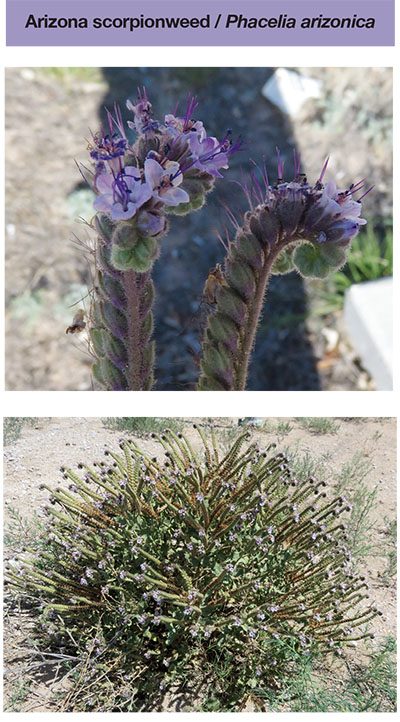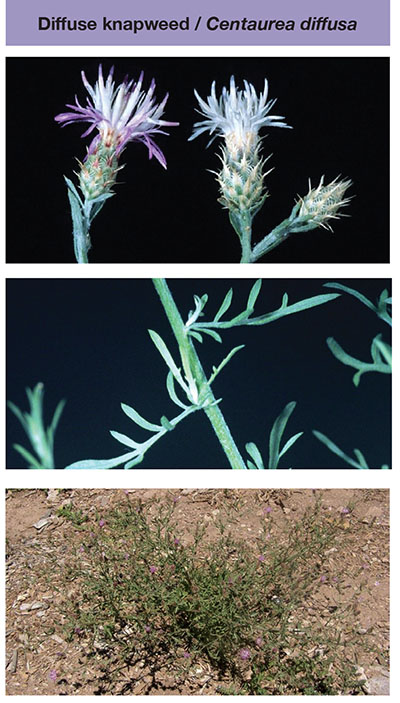Circular 698
Leslie Beck and James Wanstall
College of Agricultural, Consumer and Environmental Sciences, New Mexico State University
Authors: Respectively, NMSU Extension Weed Specialist, NMDA Natural Resource Specialist, New Mexico State University. (Print Friendly PDF)
Introduction
Weeds pose a serious and increasing threat to New Mexico’s environment and economy. These weeds are tough competitors and can spread rapidly, creating large stands that can persist for many years in the environment and cause many negative impacts to our ecosystems. While these impacts are species-specific, weeds have been documented to cause the following: displacement of native plants and animals, increased fire danger, increased soil erosion, increased flood severity, increased soil salinity, and decreased water quality. In agricultural and rangeland settings, these weeds can cause severe economic impacts by decreasing crop yields and lowering available forage for range animals, resulting in a decrease in livestock health.
This booklet focuses on helping land managers, farmers, homeowners, recreationists, and others identify troublesome weeds found in New Mexico because early detection is critical for effective weed management. Sixty-seven plant species are included in this booklet, with brief descriptions, photographs, information on what areas they invade, where they are currently located in New Mexico, and some general information on management. We urge readers to consult other resources and local experts to help determine the most appropriate management methods for their areas. Early detection and rapid response to new infestations can save many dollars and help maintain the health, diversity, and functionality of our ecosystems.
Acknowledgment
The authors wish to thank Richard D. Lee, Mark Renz, Jamshid Ashigh, Esther E. Marquez, Frank Sholedice, Ana Henke, and Susan B. Portillo for their invaluable contributions to the current and past editions of this booklet.
New Mexico Noxious Weed List
Updated June 2020
The following weeds have been selected by the New Mexico Department of Agriculture to be targeted as noxious weeds for control or eradication pursuant to the Noxious Weed Management Act of 1998. This list does not include every plant species with the potential to negatively affect the state’s environment or economy.
Class A
Class A species are currently not present in New Mexico, or have limited distribution. Preventing new infestations of these species and eradicating existing infestations are the highest priorities.
| Common name | Scientific name |
| Black henbane | Hyoscyamus niger |
| Camelthorn | Alhagi maurorum |
| Canada thistle | Cirsium arvense |
| Dalmatian toadflax | Linaria dalmatica |
| Diffuse knapweed | Centaurea diffusa |
| Dyer’s woad | Isatis tinctoria |
| Giant salvinia | Salvinia molesta |
| Hoary cress species | Cardaria spp. |
| Leafy spurge | Euphorbia esula |
| Oxeye daisy | Leucanthemum vulgare |
| Purple loosestrife | Lythrum salicaria |
| Purple starthistle | Centaurea calcitrapa |
| Ravennagrass | Saccharum ravennae |
| Scentless chamomile | Tripleurospermum perforatum |
| Scotch thistle | Onopordum acanthium |
| Spotted knapweed | Centaurea biebersteinii |
| Yellow starthistle | Centaurea solstitialis |
| Yellow toadflax | Linaria vulgaris |
Class B
Class B species are limited to portions of the state. In areas with severe infestations, management should be designed to contain the infestation and stop any further spread.
| Common name | Scientific name |
| African rue | Peganum harmala |
| Bull thistle | Cirsium vulgare |
| Chicory | Cichorium intybus |
| Halogeton | Halogeton glomeratus |
| Malta starthistle | Centaurea melitensis |
| Perennial pepperweed | Lepidium latifolium |
| Poison hemlock | Conium maculatum |
| Quackgrass | Elytrigia repens |
| Spiny cocklebur | Xanthium spinosum |
| Teasel | Dipsacus fullonum |
Class C
Class C species are widespread in the state. Management decisions for these species should be determined at the local level, based on feasibility of control and level of infestation.
| Common name | Scientific name |
| Cheatgrass | Bromus tectorum |
| Curlyleaf pondweed | Potamogeton crispus |
| Eurasian watermilfoil | Myriophyllum spicatum |
| Giant cane | Arundo donax |
| Hydrilla | Hydrilla verticillata |
| Jointed goatgrass | Aegilops cylindrica |
| Musk thistle | Carduus nutans |
| Parrotfeather | Myriophyllum aquaticum |
| Russian knapweed | Acroptilon repens |
| Russian olive | Elaeagnus angustifolia |
| Saltcedar species | Tamarix spp. |
| Siberian elm | Ulmus pumila |
| Tree of heaven | Ailanthus altissima |
Watch List
Watch List species are of concern in the state and have the potential to become problematic. More data are needed to determine if these species should be listed. When these species are encountered, please document their location and contact appropriate authorities, such as your local county NMSU Cooperative Extension Service office (https://aces.nmsu.edu/county/) or the New Mexico Department of Agriculture (https://www.nmda.nmsu.edu/nmda-homepage/divisions/apr/noxious-weed-information/).
| Common name | Scientific name |
| Buffelgrass | Pennisetum ciliare |
| Crimson fountaingrass | Pennisetum setaceum |
| Meadow knapweed | Centaurea pratensis |
| Myrtle spurge | Euphorbia myrsinites |
| Pampasgrass | Cortaderia selloana |
| Yellow bluestem | Bothriochloa ischaemum |
Troublesome Weeds Not on the New Mexico Noxious Weeds List
Updated August 2020
The following weeds have been selected by the authors of this publication as commonly observed invaders of multiple cropping systems, such as landscapes, gardens, agronomic lands, rangelands, and pastures. These plants are not listed in the Noxious Weeds List for the state of New Mexico, and may include plant species that are native to the Southwest that commonly invade certain cropping systems as a weed. Early detection and rapid response are essential with populations of these weeds for safe and successful weed control with minimal inputs and impacts to the environment. This list does not include every plant species with the potential to negatively
affect the state’s environment or economy.
| Common name | Scientific name |
| Arizona scorpionweed | Phacelia arizonica |
| Blue mustard | Chorispora tenella |
| Bouncing bet | Saponaria officinalis |
| Buckhorn plantain | Plantago lanceolata |
| Buffalo gourd | Cucurbita foetidissima |
| Climbing milkweed vine | Cynanchum laeve |
| Common lambsquarter | Chenopodium album |
| Common ragweed | Ambrosia artemisiifolia |
| Curly dock | Rumex crispus |
| Dodder species | Cuscuta spp. |
| Hare barley | Hordeum murinum |
| Prickly lettuce | Lactuca serriola |
| Purple nutsedge | Cyperus rotundus |
| Redstem filaree | Erodium cicutarium |
| Scarlet beeblossom | Gaura coccinea |
| Seaside petunia | Calibrachoa parviflora |
| Sweet clover | Melilotus officinalis |
| Tumble pigweed | Amaranthus albus |
| Western whorled milkweed | Asclepias verticillata |
| White horehound | Marrubium vulgare |
Table of Contents
Abbreviations: A = Class A, B = Class B, C = Class C, W = Watch List, T = Troublesome Weed
Listed by flower color. The flower colors listed are the most common color for each plant. Colors may vary in the field.
Arizona scorpionweed / Phacelia arizonica / T
Black henbane / Hyoscyamus niger / A
Blue mustard / Chorispora tenella / T
Bull thistle / Cirsium vulgare / B
Camelthorn / Alhagi maurorum / A
Canada thistle / Cirsium arvense / A
Crimson fountaingrass / Pennisetum setaceum / W
Diffuse knapweed / Centaurea diffusa / A
Eurasian watermilfoil / Myriophyllum spicatum / C
Meadow knapweed / Centaurea pratensis / W
Musk thistle / Carduus nutans / C
Purple loosestrife / Lythrum salicaria / A
Purple starthistle / Centaurea calcitrapa / A
Redstem filaree / Erodium cicutarium / T
Russian knapweed / Acroptilon repens / C
Saltcedar species / Tamarix spp. / C
Scotch thistle / Onopordum acanthium / A
Seaside petunia / Calibrachoa parviflora / T
Spotted knapweed / Centaurea biebersteinii / A
Teasel / Dipsacus fullonum / B
Buffalo gourd / Cucurbita foetidissima / T
Curly dock / Rumex crispus / T
Dalmatian toadflax / Linaria dalmatica / A
Dyer’s woad / Isatis tinctoria / A
Leafy spurge / Euphorbia esula / A
Malta starthistle / Centaurea melitensis / B
Myrtle spurge / Euphorbia myrsinites / W
Prickly lettuce / Lactuca serriola / T
Russian olive / Elaeagnus angustifolia / C
Sweet clover / Melilotus officinalis / T
Yellow starthistle / Centaurea solstitialis / A
Yellow toadflax / Linaria vulgaris / A
African rue / Peganum harmala / B
Bouncing bet / Saponaria officinalis / T
Buffelgrass / Pennisetum ciliare / W
Cheatgrass / Bromus tectorum / C
Climbing milkweed vine / Cynanchum laeve / T
Dodder species / Cuscuta spp. / T
Giant salvinia / Salvinia molesta / A
Halogeton / Halogeton glomeratus / B
Hare barley / Hordeum murinum / T
Hoary cress species / Cardaria spp. / A
Hydrilla / Hydrilla verticillata / C
Jointed goatgrass / Aegilops cylindrica / C
Oxeye daisy / Leucanthemum vulgare / A
Pampasgrass / Cortaderia selloana / W
Parrotfeather / Myriophyllum aquaticum / C
Perennial pepperweed / Lepidium latifolium / B
Poison hemlock / Conium maculatum / B
Quackgrass / Elytrigia repens / B
Ravennagrass / Saccharum ravennae / A
Scarlet beeblossom / Gaura coccinea / T
Scentless chamomile / Tripleurospermum perforatum / A
Siberian elm / Ulmus pumila / C
Tree of heaven / Ailanthus altissima /C
Western whorled milkweed / Asclepias verticillata / T
White horehound / Marrubium vulgare / T
Yellow bluestem / Bothriochloa ischaemum / W
Chicory / Cichorium intybus / B
Buckhorn plantain / Plantago lanceolata / T
Common lambsquarter / Chenopodium album / T
Common ragweed / Ambrosia artemisiifolia / T
Curly leaf pondweed / Potamogeton crispus / C
Purple nutsedge / Cyperus rotundus / T
Spiny cocklebur / Xanthium spinosum / B
Tumble pigweed / Amaranthus albus / T
Listed by scientific name
Acroptilon repens / Russian knapweed / C
Aegilops cylindrica / Jointed goatgrass / C
Ailanthus altissima / Tree of heaven / C
Alhagi maurorum / Camelthorn / A
Amaranthus albus / Tumble pigweed / T
Ambrosia artemisiifolia / Common ragweed / T
Asclepias verticillata / Western whorled milkweed / T
Bromus tectorum / Cheatgrass / C
Calibrachoa parviflora / Seaside petunia / T
Cardaria spp. / Hoary cress species / A
Carduus nutans / Musk thistle / C
Centaurea biebersteinii / Spotted knapweed / A
Centaurea calcitrapa / Purple starthistle / A
Centaurea diffusa / Diffuse knapweed / A
Centaurea melitensis / Malta starthistle / B
Centaurea pratensis / Meadow knapweed / W
Centaurea solstitialis / Yellow starthistle / A
Chenopodium album / Common lambsquarter / T
Chorispora tenella / Blue mustard / T
Cichorium intybus / Chicory / B
Cirsium arvense / Canada thistle / A
Cirsium vulgare / Bull thistle / B
Conium maculatum / Poison hemlock / B
Cortaderia selloana / Pampasgrass / W
Cucurbita foetidissima / Buffalo gourd / T
Cuscuta spp. / Dodder species / T
Cynanchum laeve / Climbing milkweed vine / T
Cyperus rotundus / Purple nutsedge / T
Dipsacus fullonum / Teasel / B
Elaeagnus angustifolia / Russian olive / C
Elytrigia repens / Quackgrass / B
Erodium cicutarium / Redstem filaree / T
Euphorbia esula / Leafy spurge / A
Euphorbia myrsinites / Myrtle spurge / W
Gaura coccinea / Scarlet beeblossom / T
Halogeton glomeratus / Halogeton / B
Hordeum murinum / Hare barley / T
Hydrilla verticillata / Hydrilla / C
Hyoscyamus niger / Black henbane / A
Isatis tinctoria / Dyer’s woad / A
Lactuca serriola / Prickly lettuce / T
Lepidium latifolium / Perennial pepperweed / B
Leucanthemum vulgare / Oxeye daisy / A
Linaria dalmatica / Dalmatian toadflax / A
Linaria vulgaris / Yellow toadflax / A
Lythrum salicaria / Purple loosestrife / A
Marrubium vulgare / White horehound / T
Melilotus officinalis / Sweet clover / T
Myriophyllum aquaticum / Parrotfeather / C
Myriophyllum spicatum / Eurasian watermilfoil / C
Onopordum acanthium / Scotch thistle / A
Peganum harmala / African rue / B
Pennisetum ciliare / Buffelgrass / W
Pennisetum setaceum / Crimson fountaingrass / W
Phacelia arizonica / Arizona scorpionweed / T
Plantago lanceolata / Buckhorn plantain / T
Potamogeton crispus / Curly leaf pondweed / C
Rumex crispus / Curly dock / T
Saccharum ravennae / Ravennagrass / A
Salvinia molesta / Giant salvinia / A
Saponaria officinalis / Bouncing bet / T
Tamarix spp. / Saltcedar species / C
Tripleurospermum perforatum / Scentless chamomile / A
Ulmus pumila / Siberian elm / C
Xanthium spinosum / Spiny cocklebur / B
Listed by common name
African rue / Peganum harmala / B
Arizona scorpionweed / Phacelia arizonica / T
Black henbane / Hyoscyamus niger / A
Blue mustard / Chorispora tenella / T
Bouncing bet / Saponaria officinalis / T
Buckhorn plantain / Plantago lanceolata / T
Buffalo gourd / Cucurbita foetidissima / T
Buffelgrass / Pennisetum ciliare / W
Bull thistle / Cirsium vulgare / B
Camelthorn / Alhagi maurorum / A
Canada thistle / Cirsium arvense / A
Cheatgrass / Bromus tectorum / C
Chicory / Cichorium intybus / B
Climbing milkweed vine / Cynanchum laeve / T
Common lambsquarter / Chenopodium album / T
Common ragweed / Ambrosia artemisiifolia / T
Crimson fountaingrass / Pennisetum setaceum / W
Curly dock / Rumex crispus / T
Curly leaf pondweed / Potamogeton crispus / C
Dalmatian toadflax / Linaria dalmatica / A
Diffuse knapweed / Centaurea diffusa / A
Dodder species / Cuscuta spp. / T
Dyer’s woad / Isatis tinctoria / A
Eurasian watermilfoil / Myriophyllum spicatum / C
Giant salvinia / Salvinia molesta / A
Halogeton / Halogeton glomeratus / B
Hare barley / Hordeum murinum / T
Hoary cress species/ Cardaria spp. / A
Hydrilla / Hydrilla verticillata / C
Jointed goatgrass / Aegilops cylindrica / C
Leafy spurge / Euphorbia esula / A
Malta starthistle / Centaurea melitensis / B
Meadow knapweed / Centaurea pratensis / W
Musk thistle / Carduus nutans / B
Myrtle spurge / Euphorbia myrsinites / T
Oxeye daisy / Leucanthemum vulgare / A
Pampasgrass / Cortaderia selloana / W
Parrotfeather / Myriophyllum aquaticum / C
Perennial pepperweed / Lepidium latifolium / B
Poison hemlock / Conium maculatum / B
Prickly lettuce / Lactuca serriola / T
Purple loosestrife / Lythrum salicaria / A
Purple nutsedge / Cyperus rotundus / T
Purple starthistle / Centaurea calcitrapa / A
Quackgrass / Elytrigia repens / B
Ravennagrass / Saccharum ravennae / A
Redstem filaree / Erodium cicutarium / T
Russian knapweed / Acroptilon repens / C
Russian olive / Elaeagnus angustifolia / C
Saltcedar species / Tamarix spp. / C
Scarlet beeblossom / Gaura coccinea / T
Scentless chamomile / Tripleurospermum perforatum / A
Scotch thistle / Onopordum acanthium / A
Seaside petunia / Calibrachoa parviflora / T
Siberian elm / Ulmus pumila / C
Spiny cocklebur / Xanthium spinosum / B
Spotted knapweed / Centaurea biebersteinii / A
Sweet clover / Melilotus officinalis / T
Teasel / Dipsacus fullonum / B
Tree of heaven / Ailanthus altissima / C
Tumble pigweed / Amaranthus albus / T
Western whorled milkweed / Asclepias verticillata / T
White horehound / Marrubium vulgare / T
Yellow bluestem / Bothriochloa ischaemum / W
Yellow starthistle / Centaurea solstitialis / A
Yellow toadflax / Linaria vulgaris / A
(NMSU photos by Leslie Beck.)
Troublesome Weed
Arizona scorpionweed / Phacelia arizonica
Native perennial that infests multiple different habitat types, but generally found on rocky hillsides in sandy gravelly soils, plains, and mesas. Oil from hairs on the stem, leaves, and seed pods can cause a rash similar to the effects of poison oak or poison ivy. Plant is often described as having a strong, onion-like smell.

Also Known As: Arizona phacelia, caterpillarweed, Arizona scorpion-weed
Stems/Leaves: Stems (<16 in. tall) have some branching and are densely covered with scratchy hairs; leaves (1–3 in. long, up to <1 in. wide) ovate, oblong to oblong/oblanceolate in outline, pinnatifid, lobed entire, dentate, mostly obtuse.
Flowers: Easily recognized by the white corolla with pink/purple stripes down the center of each lobe arranged in finely haired, terminal coils that often resemble a “fiddle neck.”
Roots: Taproot
Reproduction: Seed; successful management prevents seed production/spread.
Management Do’s and Don’ts
• Physical removal and mowing are effective if performed before seeds are produced.
• Burning can be used to kill plants bearing seed.
• Herbicides are effective.
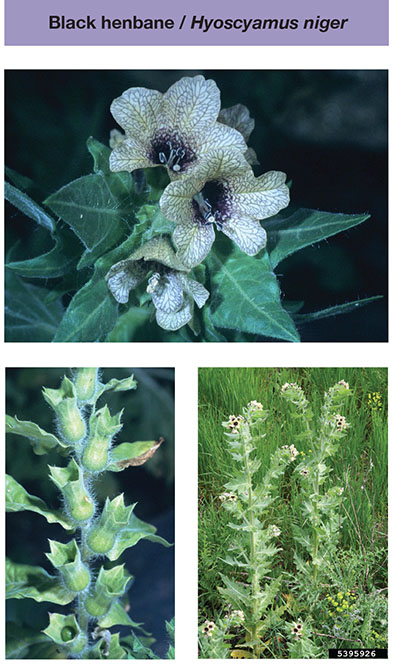
(Photos: top and bottom left by Joseph M. DiTomaso, University of California–Davis; bottom right by Robert Vidéki, Doronicum Kft., all via Bugwood.org.)
Class A
Black henbane / Hyoscyamus niger
Annual or biennial that infests disturbed, open areas, such as fields, roadsides, and waste areas; grows best in sandy, well-drained soils. All parts of the plant are toxic to humans and livestock if ingested, and it is often described as having a foul odor.

Also Known As: Cassilata, henbell, insane root, Jupiter’s bean
Stems/Leaves: Stems (1–3 ft tall) have some branching and are densely covered with long hairs; leaves (2–8 in. long, up to 6 in. wide) alternate, gray-green, oblong or lanceolate, densely covered with sticky hairs, with toothed or lobed margins.
Flowers: Five fused petals (0.8–1.2 in. long) are yellow-green with conspicuous purple veins and a purple throat; seeds found in green, oblong pods (0.5–1.2 in. long) that are covered with long hairs; pods feature an opening at one end that resembles a five-pointed crown.
Roots: Taproot
Reproduction: Seed; successful management prevents seed production/spread.
Management Do’s and Don’ts
• Physical removal and mowing are effective if performed before seeds are produced.
• Burning can be used to kill plants bearing seed.
• Herbicides are effective.
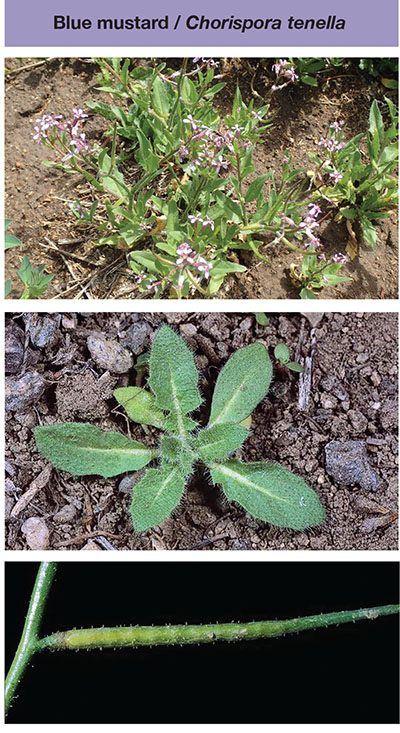
(Photos: top by Whitney Cranshaw, Colorado State University; middle and bottom by Joseph M. DiTomaso, University of California–Davis, all via Bugwoord.org.)
Troublesome weed
Blue mustard / Chorispora tenella
Annual forb that is found in waste places, pastures, and fields, and on roadsides, railroad embankments, and grassy slopes. Often described as having a “musky” odor, like melting crayons. Dairy animals eating it may produce off-flavored milk.

Also Known As: Crossflower, beanpodded mustard, common blue mustard, purple mustard
Stems/Leaves: Stems are short, leafy, erect or decumbent, and primarily branched at the base; stems have some branching and are densely covered with long hairs; leaves (0.5–5 in. long, <1 in. wide) basal, alternate, oblanceolate or oblong, with wavy or coarsely toothed margins.
Flowers/Fruits: Lavender to bright purple (rarely white) with four petals (arranged like an “X”) (<0.5 in. long and <0.01 in. wide), large and showy, petals oblanceolate, with wavy or coarsely toothed margins; fruit have a conspicuous beak, about 1/3 the length of the pod.
Roots: Taproot
Reproduction: Seed; successful management prevents seed production/spread.
Management Do’s and Don’ts
• Physical removal and mowing are effective if performed before seeds are produced.
• Shallow tillage can damage and terminate seedlings.
• Burning can be used to kill plants bearing seed.
• Herbicides are effective.
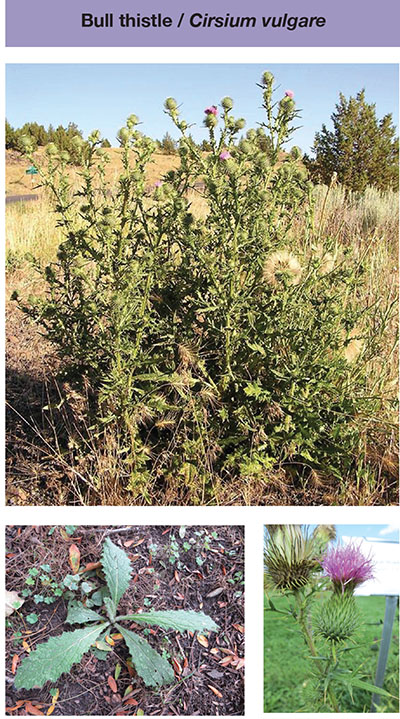
(Photos: top by Eric Coombs, Oregon Department of Agriculture, Bugwood.org; bottom left and right by Leslie Beck, NMSU.)
Class B
Bull thistle / Cirsium vulgare
Biennial (perennial under some conditions) that infests disturbed areas, such as ditches, roadsides, streams, and fences.

Also Known As: Bur thistle, common thistle, spear thistle
Stems/Leaves: Several to many branches (1–6 ft tall); stems and shoots have broad, prickly wings and some fine hairs; leaves (3–12 in. long) are dark green, lobed or toothed, often hairy, with spines (0.2–0.6 in. long) along the margins; stem leaves are more lobed and spiny than basal leaves.
Flowers: Flower heads (1.5–2 in. in diameter, 1–2 in. long) found at end of each branch, gumdrop-shaped or spherical, often covered with fine, cobweb-like hairs; flowers are purple, rarely white; below flowers are many long, stiff, yellow or green spiny bracts (1–1.5 in. long).
Roots: Taproot
Reproduction: Seed; successful management prevents seed production/spread.
Management Do’s and Don’ts
• Proper identification is important—can be confused with native thistles like the threatened Sacramento Mountain thistle (Cirsium vinaceum).
• Mechanical removal should cut roots below the soil surface and remove stems before flowering.
• Herbicides are effective.
• DO NOT mow during/after flowering to prevent seed dispersal.
• DO NOT use fire—it creates favorable conditions for growth.

(Photos: top by Yurly75, Creative Commons; middle by John M. Randall, The Nature Conservancy, Bugwood.org; bottom by Steve Dewey, Utah State University, Bugwood.org.)
Class A
Camelthorn / Alhagi maurorum
Herbaceous perennial that infests a wide range of areas, particularly semiarid areas along rivers and floodplains where plant communities are degraded, as well as disturbed areas, such as roadsides, ditches, and fields.

Also Known As: Alhagi pseudoalhagi
Stems/Leaves: Multiple green stems (1–4 ft tall) with fine branching; mature stems glabrous; narrow to oblong leaves (<1 in. long) alternate; stems and branches end in thorny spines (0.5–1.0 in. long).
Flowers/Fruits: Pea-like flowers with pink, purple, or white petals (0.3–0.4 in. long) found on short racemes of 1–8 flowers; produces reddish-brown fruit pods (0.4–1.2 in. long) with distinct restrictions around seeds.
Roots: Extensive creeping perennial root system; semi-woody.
Reproduction: Vegetative or seed reproduction; root reproduction is most common, though seeds can remain viable for years.
Management Do’s and Don’ts
• Preventing infestations and maintaining a healthy plant community are the best management methods.
• Hand removal is effective if most of the root system can be removed.
• Herbicides are effective.
• Mechanical removal techniques spread root fragments and are ineffective.
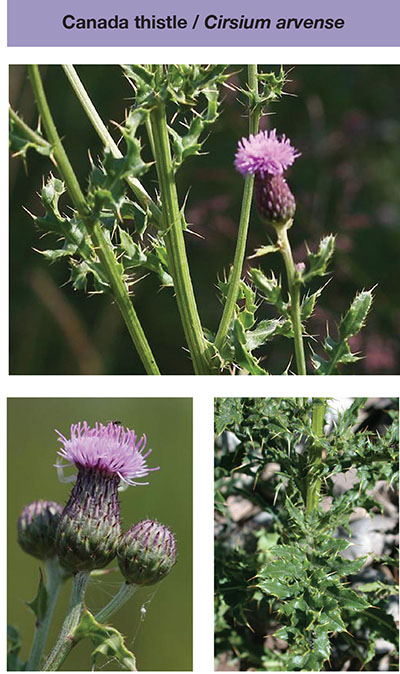
(Photos: top and bottom left by Rob Routledge, Sault College; bottom right by Mary Ellen (Mel) Harte, all via Bugwood.org.)
Class A
Canada thistle / Cirsium arvense
Perennial that infests disturbed sites, such as roadsides and open fields, as well as hillsides, open forests, pastures, rangelands, crop fields, stream banks, and other riparian areas.

Also Known As: Corn thistle, creeping thistle
Stems/Leaves: Stems (1–4 ft tall) are nearly glabrous, branched near the top, green to brown; leaves (2–8 in. long) are green, oblong to lanceolate; leaf margins are wavy, lobed, or toothed with prickly spines (0.1–0.25 in. long).
Flowers: Produces flower heads in clusters; individual heads (0.5 in. in diameter, 0.5–1.5 in. long) are oval- to bell-shaped, with dark-tipped bracts below flowers; flowers are pink, purple, or white.
Roots: Extensive creeping perennial root system.
Reproduction: Creeping perennial roots and seed reproduction.
Management Do’s and Don’ts
• Early detection and eradication are the most effective control methods.
• Repeated cultivation, mowing (before seed production), or hand removal is effective.
• Herbicides are effective.
• Maintaining a healthy plant community can prevent establishment and slow spread.
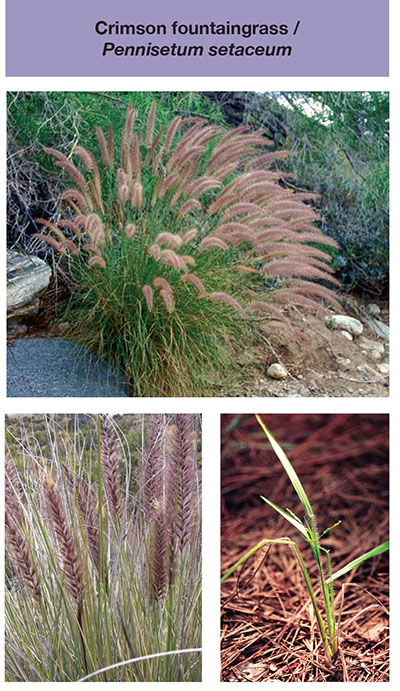
(Photos: top by John M. Randall, The Nature Conservancy; bottom left by Forest and Kim Starr, Starr Environmental; bottom right by James H. Miller, USDA Forest Service, all via Bugwood.org.)
Watch List
Crimson fountaingrass / Pennisetum setaceum
Tufted perennial grass that infests disturbed areas, such as ditches, roadsides, and urban areas, as well as desert shrubland.
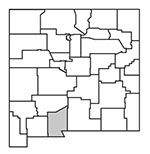
Also Known As: Fountaingrass, tender fountaingrass
Stems/Leaves: Round stems (up to 3.5 ft tall) form dense clumps; leaves (8–26 in. long, 0.08–0.16 in. wide) are flat, sometimes with a keeled midvein; leaf margins have long, white hairs, especially near sheaths; sheaths are closed and extend 1.5–3 in. down stem.
Flowers: Tufted, bristly panicles (3–12 in. long, 1.5–2 in. wide) are pink to purple and may droop.
Roots: Deep, fibrous root system.
Reproduction: Seed; successful management prevents seed production/spread.
Management Do’s and Don’ts
• Prevention and early detection are the most effective control methods.
• Hand removal of individual plants is most effective in preventing new infestations.
• Herbicides are effective.
• Fire is NOT effective.
(Photos: top and middle by Joseph M. DiTomaso, University of California-Davis; bottom by Bonnie Million, Bureau of Land Management, all via Bugwood.org.)
Class A
Diffuse knapweed / Centaurea diffusa
Herbaceous biennial (sometimes annual or short-lived perennial) that tolerates a wide range of conditions, but mostly infests disturbed areas, such as roadsides, ditches, open fields, semiarid deserts, rangelands, and grasslands.
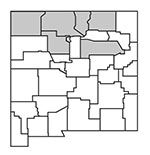
Also Known As: White knapweed
Stems/Leaves: Numerous branching, bushy stems (1–3 ft tall) are green to brown; leaves (4–8 in. long) alternate, often covered with grayish hairs; lower leaves are deeply lobed; upper leaves are linear and entire, DO NOT form wings on stem.
Flowers: Single flower head (0.5 in. long, 0.2 in. wide) at end of each branch with white flowers (sometimes rose to light purple); below flowers are several straw-colored bracts each with comb-like edges and a spiny tip.
Roots: Taproot
Reproduction: Seed; successful management prevents seed production/spread.
Management Do’s and Don’ts
• Mechanical removal must remove at least 3–4 in. of root crown.
• Thirteen biological control agents have been introduced.
• Herbicides are effective with proper timing.
• Mow plants at late bud or early bloom to reduce seed production.
• Fire is NOT effective.
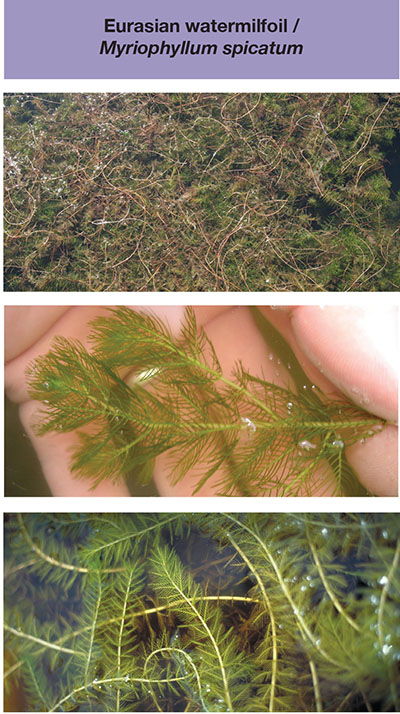
(Photos: top by Chris Evans, University of Illinois; middle by Graves Lovell, Alabama Department of Conservation and Natural Resources; bottom by Alison Fox, University of Florida, all via Bugwood.org.)
Class C
Eurasian watermilfoil / Myriophyllum spicatum
Aquatic perennial that infests riparian areas, such as lakes, ponds, rivers, streams, and irrigation ditches; usually found in still or slow-moving water, but occasionally in fast-moving streams or rivers.
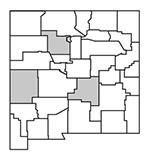
Also Known As: Spike watermilfoil
Stems/Leaves: Submersed stems (up to 15 ft long) branched near water surface, green, brown, or reddish; leaves (0.5–1.5 in. long) normally 4-whorled, pinnate-divided, with opposite pairs of narrow lobes (0.4 in. long), usually more than 14 pairs per leaf; lobes are linear and green to brown.
Flowers: Four pinkish petals or sepals (0.04–0.12 in. long) as well as small, bract-like leaves (0.04–0.12 in. long); numerous small flowers found on erect or immersed inflorescence (1.6–3.2 in. long).
Roots: Numerous creeping, branched rhizomes that form large, thick surface or subsurface mats.
Reproduction: Vegetative reproduction from rhizomes, stem fragments, or buds on leaf axils.
Management Do’s and Don’ts
• Repeated mechanical removal is effective at controlling density, but stem fragments may escape and form new infestations.
• Removing stem fragments and plant parts from boats, lines, and fishing gear can help prevent spread of infestations.
• Herbicides are effective.
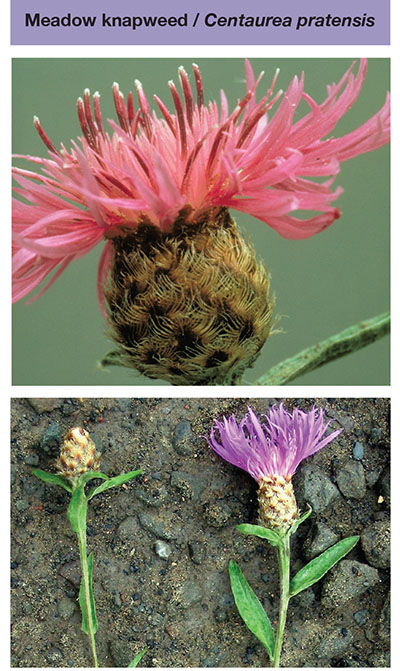
(Photos: top by Cindy Roche; bottom by Great Smoky Mountains National Park Resource Management, USDI National Park Service, both via Bugwood.org.)
Watch List
Meadow knapweed / Centaurea pratensis
Perennial that infests rangelands, pastures, grasslands, meadows, and open forests.
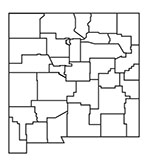
Also Known As: Bull clover
Stems/Leaves: Several branching stems (1.5–3.3 ft tall); basal leaves (up to 6 in. long, 1.25 in. wide) are tapered at both ends, lower stem leaves are lanceolate with entire or shallow lobed margins, upper stem leaves are smaller and entire.
Flowers: Single flower head (0.75 in. in diameter) grows at the end of each branch, oval- or globe-shaped, with light or dark brown to black papery bracts; flowers are purple or rose, sometimes white.
Roots: Taproot
Reproduction: Perennial root crown and seed.
Management Do’s and Don’ts
• Physical removal and cultivation are effective.
• Herbicides are effective.
• Seed head gall fly, Urophora quadrifasciata, is an introduced biological control.
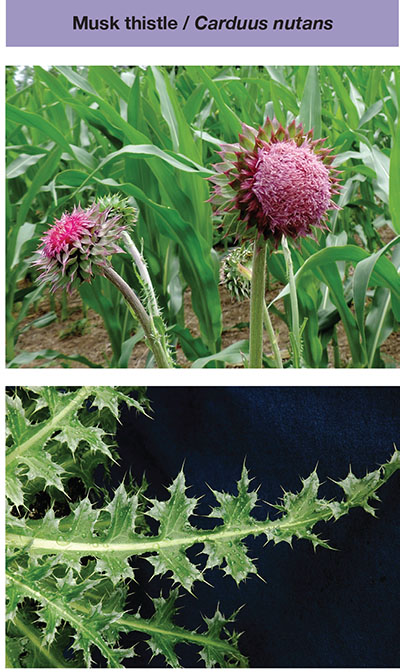
(Photos: top by Richard Gardner; bottom by Bruce Ackley, The Ohio State University, both via Bugwood.org.)
Class C
Musk thistle / Carduus nutans
Biennial that typically infests disturbed open areas, waste areas, stream banks, ditches, and roadsides.
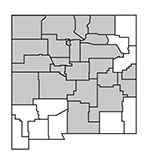
Also Known As: Nodding thistle, plumeless thistle
Stems/Leaves: Stems (2–6 ft tall) have some branching, sometimes densely hairy, with narrow wings formed by leaf bases; leaves (4–15 in. long) are dark green with light green center, deeply lobed, with spiny margins.
Flowers: Flower heads (1.5–3 in. in diameter) mostly spherical, found at branch ends, and often droop; flowers are pink to purple in color, rarely white; below flowers are numerous green, purple, or straw-colored bracts (0.1–0.3 in. wide), often covered with cobweb-like hairs; bracts are usually lanceolate.
Roots: Taproot
Reproduction: Seed; successful management prevents seed production/spread.
Management Do’s and Don’ts
• Mechanical removal should cut roots below soil surface and remove stems before flowering.
• Herbicides are effective.
• Several biological controls exist, but none are legal in NM.
• DO NOT use fire—it creates favorable conditions for growth.
• DO NOT mow during/after flowering to prevent seed dispersal; mow plants in late bud or early bloom to reduce seed production.
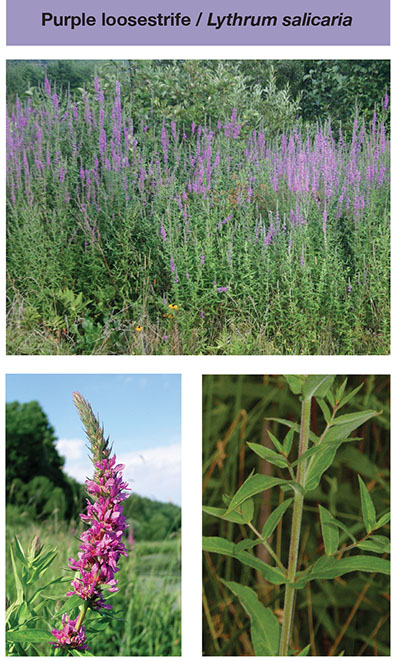
(Photos: top and bottom right by Leslie J. Mehrhoff, University of Connecticut; bottom left by Linda Wilson, University of Idaho, all via Bugwood.org.)
Class A
Purple loosestrife / Lythrum salicaria
Perennial found in wetlands along rivers, streams, lakes, ponds, floodplains, reservoirs, and ditches, as well as in some disturbed areas.

Also Known As: Bouquet violet, purple lythrum
Stems/Leaves: Multiple branched stems (1–6 ft tall) are green to purple or brown, 4- to 5-sided, often covered with small hairs; plants may form a clump or bush; leaves (2–6 in. long) are narrow or lanceolate with smooth margins, attach directly to stem in opposite or whorled arrangement.
Flowers: Found on elongated racemes; 5–7 pinkish-purple petals (<0.5 in. long) surrounding a yellow center.
Roots: Taproot with locally spreading perennial roots.
Reproduction: Stem fragments or seed reproduction, but mostly through seed.
Management Do’s and Don’ts
• Prevention and early detection are the most effective control methods.
• Physical removal before flowering for single plants/small infestations.
• Several effective biological control agents have been introduced.
• Herbicides are effective.
• DO NOT MOW.
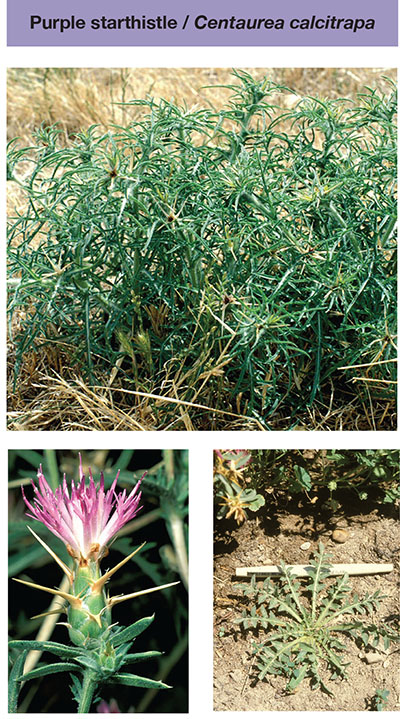
(Photos: top and bottom left by Barry Rich, sarracenia.com; bottom right by Steve Dewey, Utah State University, all via Bugwood.org.)
Class A
Purple starthistle / Centaurea calcitrapa
Annual to perennial that infests open fields, roadsides, grasslands, rangelands, and especially disturbed areas; also found in fertile or alluvial soils.

Also Known As: Red starthistle
Stems/Leaves: Numerous, highly branched stems (up to 4 ft tall); plants may form clumps or bushes; leaves (4–8 in. long) alternate, covered with long, wooly hairs; lower leaves deeply lobed; upper leaves pinnate-divided with narrow leaflets, DO NOT form wings on upper stems.
Flowers: Oval-shaped flower heads (0.75–1 in. long) borne on leafy stems; flowers are deep purple to lavender; below flowers are several stiff, straw-colored spines (0.4–1 in. long).
Roots: Taproot
Reproduction: Seed; successful management prevents seed production/spread.
Management Do’s and Don’ts
• Physical removal before seed production for single plants/small infestations.
• Herbicides are effective.
• DO NOT MOW.

(Photos: top by Joseph Berger, Bugwood.org; middle and bottom by Leslie Beck, NMSU.)
Troublesome Weed
Redstem filaree / Erodium cicutarium
Annual to biennial herbaceous weed commonly found in disturbed, dry soils below 8,000 ft in elevation.
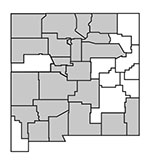
Also Known As: Stork’s bill, crane’s bill, heron bill
Stems/Leaves: Stems can grow up to 15 in. tall, but typically less than 4 in. in the Southwest; few to several stems that initially grow erect and become prostrate with maturity, often reddish-purplish in color; leaves short-petiolate; blades (1–5 in. long) bipinnatifid (twice pinnately cleft), with fine feathery divisions; leaves overwinter as a basal rosette, opposite along the stem during the growing season.
Flowers: Five separate hairy petals arranged in the shape of a star; lavender, pink, or lilac in color, often spotted, with five sepals.
Roots: Taproot
Reproduction: Seed; successful management prevents seed production/spread.
Management Do’s and Don’ts
• Physical removal before seed production for single plants/small infestations.
• Herbicides are effective.
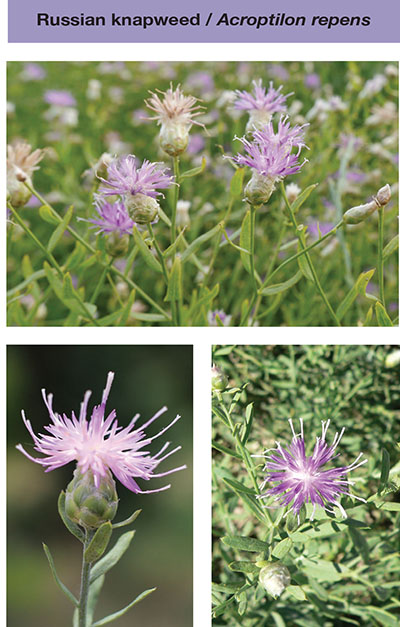
(Photos: top by Thayne Tuason and bottom right by Stan Shebs, both via Creative Commons; bottom left by Leslie Beck, NMSU.)
Class C
Russian knapweed / Acroptilon repens
Herbaceous perennial that invades pastures, degraded croplands, alfalfa fields, rangelands, roadsides, riparian areas, and irrigation ditches.
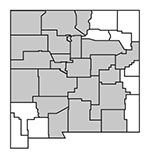
Also Known As: Hardheads, Russian starthistle, Turkestan thistle
Stems/Leaves: Numerous branching stems (1–3 ft tall); lower leaves (1.5–4 in. long) alternate and have lobed or wavy margins; upper leaves are linear or lanceolate; leaves are green to light green and DO NOT form wings on stems; leaves and stems covered with dense gray hairs.
Flowers: Flower heads (0.25–0.5 in. diameter) round or hemispheric, with pink, lavender, or white flowers; below flowers are numerous green, papery bracts.
Roots: Extensive creeping root system; roots have a brown to black scaly appearance, especially near soil surface.
Reproduction: Vegetative and seed reproduction; most reproduction is from buds on creeping perennial root system.
Management Do’s and Don’ts
• Prevention and early detection are essential; large infestations are extremely difficult to control.
• Prevention and maintenance of a healthy plant community are the best management methods.
• Herbicides are effective.
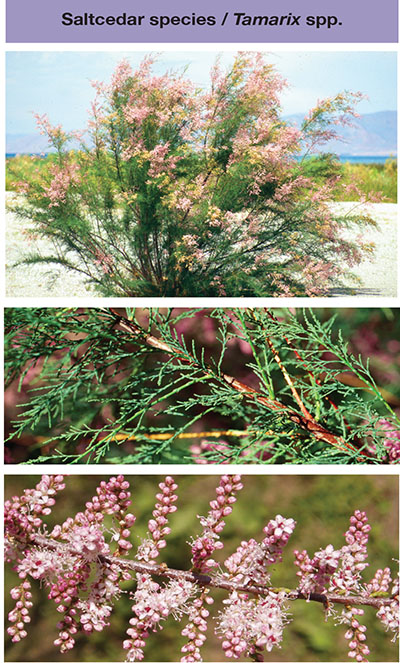
(Photos: top and middle by Steve Dewey, Utah State University; bottom by Leslie J. Mehrhoff, University of Connecticut, all via Bugwood.org.)
Class C
Saltcedar species / Tamarix spp.
Small shrubs or trees that infest riparian areas, such as rivers, streams, lake and pond shores, and irrigation ditches, as well as roadsides and rangelands.
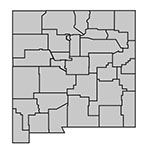
Also Known As: Tamarisk, tamarix
Stems/Leaves: One or more trunks (5–25 ft tall) may be covered with rough bark; numerous dense, thin, branching stems and twigs have smooth, reddish-brown bark; leaves (0.06–0.14 in. long) small and scale-like, alternate, oval to lanceolate, often overlapping, green, gray-green, or blue-green in color.
Flowers: Produces long racemes (0.12–0.2 in. wide, several inches long) with numerous small flowers; flowers have four to five sepals or petals that are white to dark pink in color.
Roots: Taproot with numerous spreading lateral roots.
Reproduction: Root crown or seed reproduction, but primarily through seed.
Management Do’s and Don’ts
• Physical removal is only effective if the root crown is removed.
• Herbicides are effective, but aboveground tissue must not be removed after treatment, for a period of up to 4 years.
• Individual tree methods should be utilized in low-density stands.
• Established native vegetation can out-compete saltcedar seedlings.
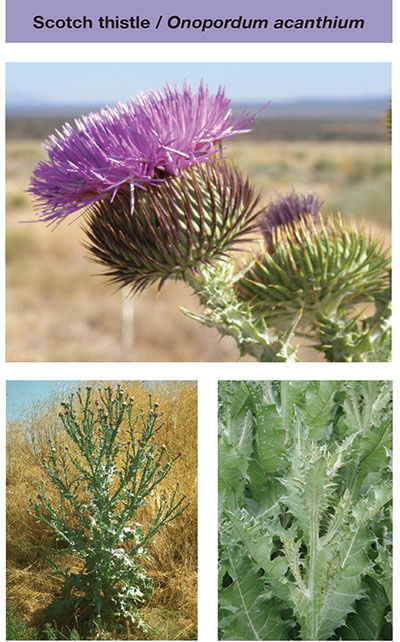
(Photos: top by Bonnie Million, Bureau of Land Management; bottom left by Steve Dewey, Utah State University; bottom right by Robert Vidéki, Doronicum Kft., all via Bugwood.org.)
Class A
Scotch thistle / Onopordum acanthium
Biennial that infests disturbed sites, such as roadsides, ditches, and open fields, as well as pastures, rangelands, grasslands, riparian areas, and irrigation ditches.
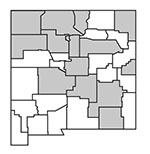
Also Known As: Cotton thistle, heraldic thistle, jackass thistle, Queen Mary’s thistle, wooly thistle, winged thistle
Stems/Leaves: Stems (4–12 ft tall) are branched near the top, covered with wooly, gray hairs, and have conspicuous broad, spiny wings along the entire stem; leaves (4–20 in. long, 0.8–1.2 in. wide) are oblong, covered with wooly, gray hairs, margins are toothed or lobed with sharp, stiff spines.
Flowers: Flower heads (up to 2 in. in diameter) are round or hemispherical, covered with numerous green to purple or straw-colored, overlapping, spiny bracts (0.2 in. long or less), often with wooly hairs; flowers are white to purple.
Roots: Taproot
Reproduction: Seed; successful management prevents seed production/spread.
Management Do’s and Don’ts
• Physical removal before seed production is effective for small infestations.
• Minimizing open areas and establishing competitive plants, especially perennial grasses, can discourage invasion.
• Herbicides are effective.
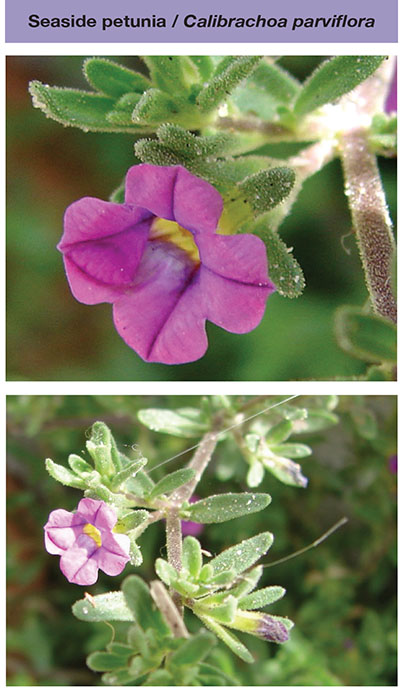
(Photos by L’herbier en photos, Creative Commons.)
Troublesome Weed
Seaside petunia / Calibrachoa parviflora
Spreading annual herbaceous weed that is commonly found on sandy flats, arroyos, sand bars, stream banks, and disturbed agricultural fields.
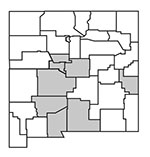
Also Known As: Small flower petunia
Stems/Leaves: Stems (1–15 in. long) are prostrate and diffusely branched; leaves are alternate to sub-opposite along the stems, sessile or on short petioles; blades oblong-linear (<0.5 in. long and <0.2 in. wide) and fleshy, with glandular hairs (looks sparkly in the sunlight).
Flowers: Small and purple, located within leaf axils, on short slender pedicels; calyx is five-lobed petunia-like flower on a funnel-shaped corolla with a purple and whitish tube.
Roots: Taproot
Reproduction: Seed; successful management prevents seed production/spread.
Management Do’s and Don’ts
• Physical removal before seed production is effective for small infestations.
• Minimizing open areas and establishing competitive plants, especially perennial grasses, can discourage invasion.
• Herbicides are effective.
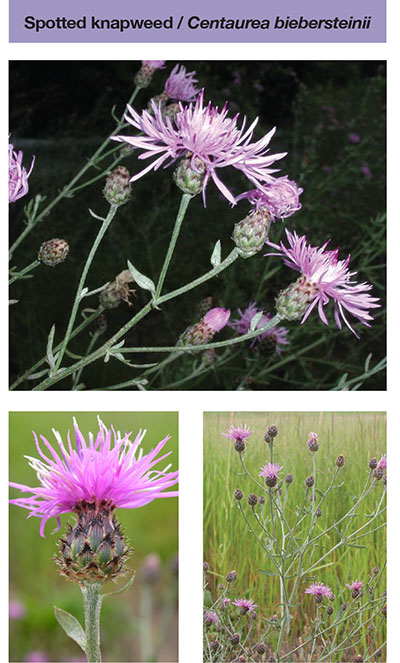
(Photos: top by Leslie J. Mehrhoff, University of Connecticut, Bugwood.org; bottom left and right by Matt Lavin, Creative Commons.)
Class A
Spotted knapweed / Centaurea biebersteinii
Herbaceous biennial to short-lived perennial that tolerates a wide range of conditions, but mostly infests disturbed areas, such as roadsides, ditches, open fields, semiarid deserts, rangelands, and grasslands.
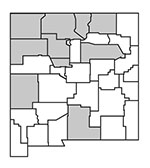
Also Known As: Centaurea maculosa
Stems/Leaves: Numerous branching stems (up to 4 ft tall); leaves (4–8 in. long) alternate, often covered with grayish hairs; lower leaves deeply lobed; upper leaves pinnate-divided with narrow, entire leaflets; upper leaves DO NOT form wings on stems.
Flowers: Single flower head (0.4–0.5 in. long, 0.3–0.5 in. wide) at end of each branch; flowers usually pinkish-purple, sometimes light purple to white; below flowers are green bracts, each with a dark brown to black comb-like tip.
Roots: Taproot
Reproduction: Seed; successful management prevents seed production/spread.
Management Do’s and Don’ts
• Preventing seed dispersal and establishing competitive vegetation are essential.
• Mechanical removal must remove at least 3–4 in. of root crown.
• Thirteen biological control agents have been introduced.
• Herbicides are effective.
• Fire is NOT effective.
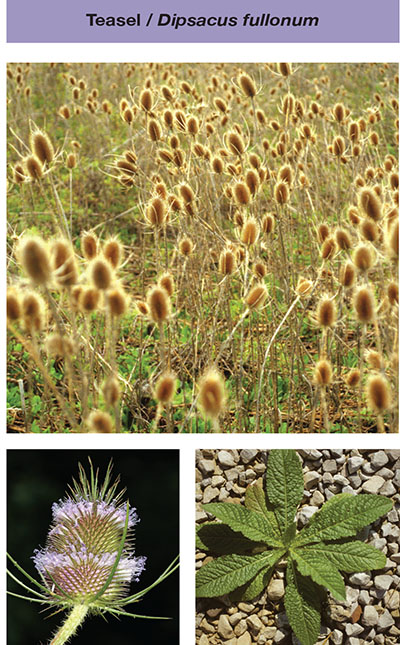
(Photos: top by Steve Dewey, Utah State University; bottom left by David Cappaert; bottom right by Theodore Webster, USDA Agricultural Research Service, all via Bugwood.org.)
Class B
Teasel / Dipsacus fullonum
Biennial but occasionally short-lived perennial that infests disturbed areas, such as fields, roadsides, waste grounds, and ditches.
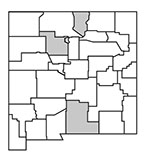
Also Known As: Wild teasel, card thistle, Fuller’s teasel, Venus-cup
Stems/Leaves: Flowering stems (up to 6 ft) develop during the second season and branch near the upper portion; stems have several angled rows of downward prickles; basal rosette leaves are oblanceolate and usually die early in the second season; stem leaves are sessile, lanceolate, and opposite; all leaves have short, stiff prickles on the lower midvein.
Flowers: Flower heads (1.25–4 in. long) with dense white to purple flowers that bloom in a circular pattern around the ovoid to cylindrical heads; bracts at the base of the heads are prickly and generally longer than the heads; individual flowers (0.4–0.6 in. long) have spine-like bractlets.
Roots: Taproot
Reproduction: Seed; successful management prevents seed production/spread.
Management Do’s and Don’ts
• Mowing the flowering stems prior to seed production is effective.
• Cover crops will help reduce establishment.
• Herbicides are effective.
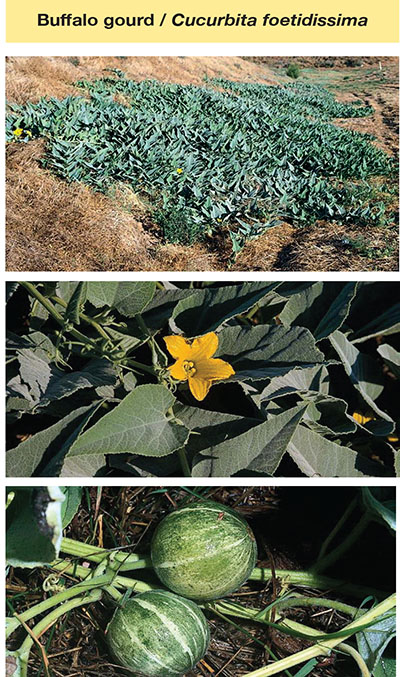
(Photos by Joseph M. DiTomaso, University of California–Davis, Bugwoord.org.)
Troublesome Weed
Buffalo gourd / Cucurbita foetidissima
Malodorous perennial herbaceous vine that invades areas of disturbed soils in pastures, rangelands, roadsides, riparian areas, and irrigation ditches.
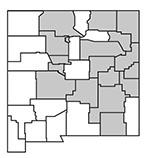
Also Known As: Stinking gourd, wild gourd, buffalo gourd pumpkin
Stems/Leaves: Stems are coarse (leathery), with a vine-like growth pattern along the soil surface, forming a dense ground coverage up to 15 in. tall; leaves alternate along the stem and generally point upwards; blades triangular (4–8 in. long), with thick, scabrous petioles about half the length of the attached leaf; leaves are evenly distributed along the stem and get progressively smaller toward the tips of the stem.
Flowers/Fruits: Flowers large and yellow; plant is monoecious; five petals arranged in a large bell-shaped corolla (4 in. long); fruits are spherical gourds (<3 in. in diameter), with whitish stripes; gourds turn yellowish-green at maturity and are toxic when consumed by humans, although they have medicinal properties in moderation.
Roots: Large tuberous, deeply penetrating root. Some reports indicate the root is toxic.
Reproduction: Seed; successful management prevents seed production/spread.
Management Do’s and Don’ts
• Prevention and early detection are essential; large infestations are extremely difficult to control.
• Physical removal can be successful if the extensive taproot system is removed.
• Herbicides are effective.
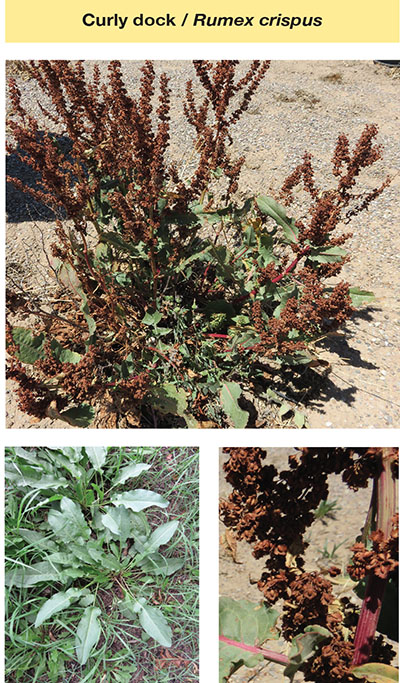
(Photos by Leslie Beck, NMSU.)
Troublesome Weed
Curly dock / Rumex crispus
Herbaceous perennial that is generally found in moist areas of disturbed soils.

Also Known As: Narrowleaf dock, sour dock, yellow dock
Stems/Leaves: Stems are stout, erect (10–50 in. tall), simple or branched above the middle, smooth, and greenish/reddish in color; leaves formed in a basal rosette and alternate along the erect stems on thin, pitted petioles; basal leaves lanceolate (4–15 in. long) with ruffled (crisped) edges; stem leaves are similar in shape but smaller.
Flowers/Fruits: Flowers are greenish in color, and in a terminal panicle that occupies the space in the top half of the plant; each flower has three outer bract-like tepals and three winged inner tepals, called valves, which get slightly larger when in fruit; fruits are achenes, reddish-brown in color, and surrounded by three enlarged inner tepals.
Roots: Extensive simple taproot.
Reproduction: Seed; successful management prevents seed production/spread.
Management Do’s and Don’ts
• Prevention and early detection are essential; large infestations are extremely difficult to control.
• Prevention and maintenance of a healthy plant community are the best management methods.
• Prevent development of overly moist soils in disturbed sites through improved drainage and proper irrigation practices.
• Herbicides are effective.
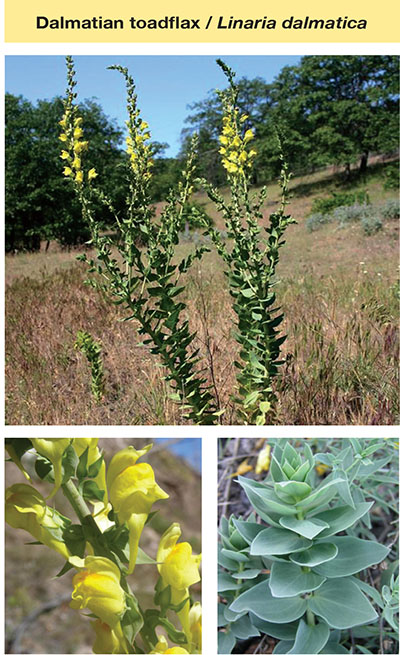
(Photos: top by Eric Coombs, Oregon Department of Agriculture; bottom left by Bonnie Million, Bureau of Land Management; bottom right by Linda Wilson, University of Idaho, all via Bugwood.org.)
Class A
Dalmatian toadflax / Linaria dalmatica
Herbaceous perennial that invades disturbed areas along roadsides, ditches, abandoned lots and fields, rangelands, riparian communities, and crop fields.
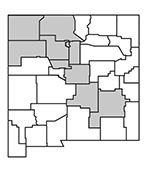
Also Known As: Broad-leaf toadflax, wild snapdragon
Stems/Leaves: Stems (up to 4 ft tall) are smooth and waxy at the base, herbaceous and branching near the top; leaves (0.5–2.3 in. long) alternate and clasp stem; waxy, bluish-green in color; oval, heart-shaped, or lanceolate.
Flowers: Resemble snapdragons; petals are 0.75–1.5 in. long; flowers are two-lipped, yellow, with an orange, bearded throat and a long spur.
Roots: Taproot and creeping perennial roots.
Reproduction: Vegetative and seed reproduction; most new populations are established by seed.
Management Do’s and Don’ts
• Maintenance of a healthy plant community and prevention are the best management methods.
• Hand pull small infestations.
• Eight biological control agents have been approved for use.
• Herbicides are effective.
• Fire and mowing are NOT effective control methods.
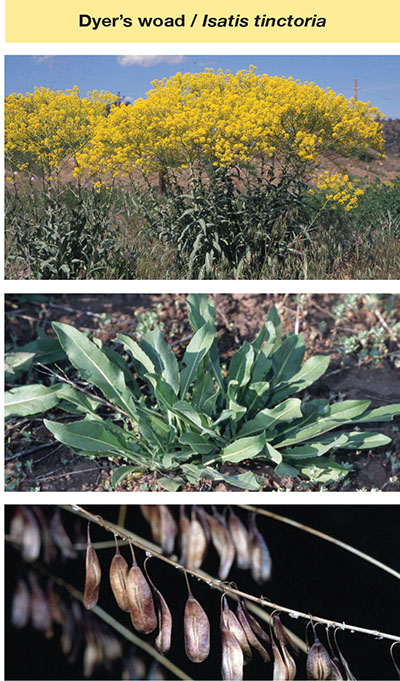
(Photos by Joseph M. DiTomaso, University of California–Davis, Bugwoord.org.)
Class A
Dyer’s woad / Isatis tinctoria
Annual, biennial, or short-lived perennial that infests gravel pits, roadsides, trails, railroads, and other disturbed areas with sandy or rocky soil; also infests hay and grain fields.
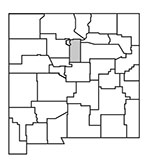
Also Known As: Marlahan mustard
Stems/Leaves: Stems (1–4 ft long) are highly branched near top; leaves (1.5–7 in. long, 0.4–1.5 in. wide) are green to blue-green, lanceolate, clasp the stem, and have a conspicuous cream-colored midvein from base to tip.
Flowers: Small, bright yellow flowers found in clustered inflorescences on upper stems, with four petals (0.125 in. long) per flower; seed pods (0.375 in. long, 0.125 in. in diameter) are flattened, teardrop-shaped, and suspended from a small stalk; immature pods are green while mature pods are dark purplish-brown to black.
Roots: Taproot
Reproduction: Seed; successful management prevents seed production/spread.
Management Do’s and Don’ts
• Mechanical removal should remove roots at least 3–4 in. below soil.
• Mowing at early to mid-flower stage PRIOR TO seed formation is effective.
• Herbicides are effective.
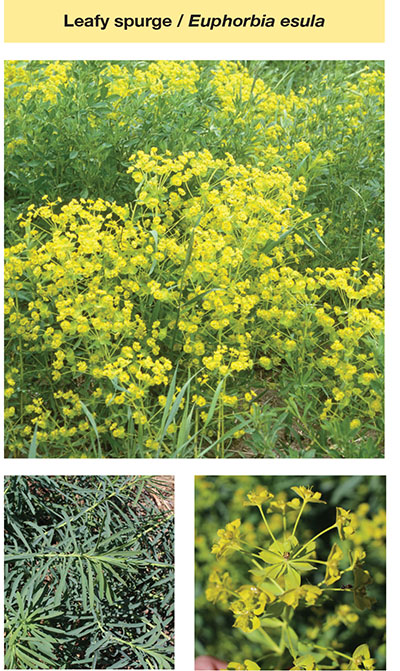
(Photos: top by Steve Dewey, Utah State University, Bugwood.org; bottom left and right by Leslie Beck, NMSU.)
Class A
Leafy spurge / Euphorbia esula
Herbaceous perennial that is adapted to many soil types and habitats; typically invades disturbed and undisturbed areas, such as pastures, rangelands, abandoned croplands, roadsides, wetlands, woodlands, floodplains, riparian areas, mountain ridges, and prairies. Its milky sap may cause skin and eye irritation in humans and be toxic to cattle if ingested in large quantities.
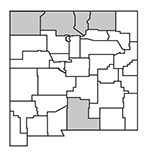
Also Known As: Faitours-grass, wolf’s milk
Stems/Leaves: Stems (1–3 ft tall) are woody at the base, branched at the top, glabrous, with milky sap; leaves (1–4 in. long) are linear to oblong in shape, mostly alternate, with smooth margins; stems and leaves are pale blue-green.
Flowers: Produces showy, green to yellow, heart- or kidney-shaped bracts at ends of stems; flowers form within bracts, with one three-chambered ovary on top of 11–21 smaller, five-sepaled male flowers.
Roots: Extensive creeping perennial root system.
Reproduction: Perennial roots and seed reproduction.
Management Do’s and Don’ts
• Maintenance of a healthy plant community and prevention are the best management methods.
• Physical removal is largely ineffective.
• Numerous effective biological control agents have been introduced.
• Herbicides are effective.
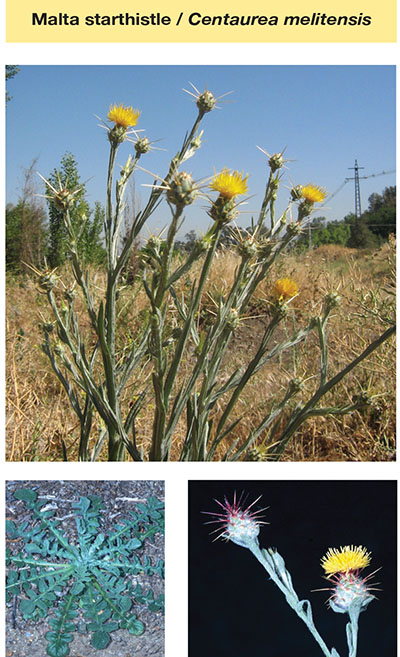
(Photos: top by Penarc, Creative Commons; bottom left and right by Joseph M. DiTomaso, University of California–Davis, Bugwoord.org.)
Class B
Malta starthistle / Centaurea melitensis
Annual (occasionally biennial) that infests disturbed areas, such as roadsides and open fields, as well as rangelands, grasslands, open woodlands, pastures, and crop fields.
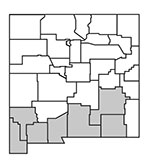
Also Known As: Tocolote, Maltese starthistle
Stems/Leaves: Stiff, wiry stems (1–3 ft tall) often branched; leaves (0.8–6 in. long) are green to blue-green, covered with fine hairs; basal leaves are oval to linear, entire to lobed margins; stem leaves are narrow, entire to wavy margins, with bases that extend down the stem creating wings (0.12 in. wide).
Flowers: Flower heads (0.4–0.8 in. in diameter) found singly or in groups of 2–3 at ends of stems, oval in shape, with yellow flowers; stiff purple or brown bracts (0.2–0.6 in. long) are found beneath flowers.
Roots: Taproot
Reproduction: Seed; successful management prevents seed production/spread.
Management Do’s and Don’ts
• Prevention and early detection are the most effective control methods.
• Frequent cultivation is effective.
• Mow plants in late bud or early bloom to reduce seed production.
• Burning is effective if done before seed production.
• Herbicides are effective.
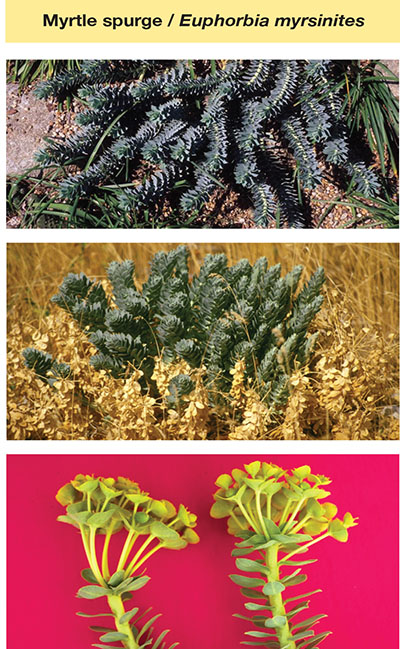
(Photos: top by John Ruter, University of Georgia; middle and bottom by Steve Dewey, Utah State University, all via Bugwood.org.)
Watch List
Myrtle spurge / Euphorbia myrsinites
Perennial herbaceous weed that is often found in rock gardens and landscapes, and is moving into natural areas where it has the potential to do environmental damage. Contains a very corrosive milky sap that can cause redness, swelling, and blisters when contacting the skin, and damage/blindness if it contacts the eyes. Sap can also cause nausea, vomiting, and diarrhea when ingested.
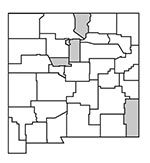
Also Known As: Donkey tail, creeping spurge
Stems/Leaves: Mature plants (up to 4–6 in. tall) spread up to 18 inches wide each growing season; leaves alternate, and arranged in close spirals, thick, fleshy, and blue-green in color.
Flowers: Flowers are inconspicuous, yellow, and surrounded by a large yellow-green bract; seeds can be projected from the plant up to 15 feet and can survive in the soil for roughly 8 years.
Roots: Extensive creeping root system.
Reproduction: Vegetative and seed reproduction; most reproduction is from buds on creeping perennial root system.
Management Do’s and Don’ts
• Physical removal is only effective if the extensive root system is removed.
• Intense cultivation and planting competitive plants can be helpful in fields.
• Minimizing open areas and establishing competitive plants, especially perennial grasses, can discourage invasion.
• Grazing with sheep or goats.
• Herbicides are effective.
• DO NOT MOW.
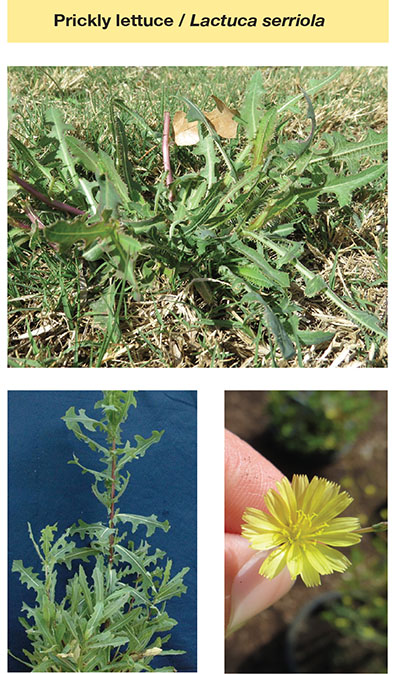
(Photos: top and bottom right by Leslie Beck, NMSU; bottom left by Bruce Ackley, The Ohio State University, Bugwood.org.)
Troublesome Weed
Prickly lettuce / Lactuca serriola
Annual to biennial herbaceous weed commonly found in fields, waste spaces, disturbed areas, and roadsides.

Also Known As: Wild lettuce, winter’s lettuce, compass plant
Stems/Leaves: Stems are erect (10–60 in. tall), typically smooth but can have prickles at the base; leaves are simple, alternate, sessile, with large prickles on the underside of the midrib and finer prickles on the pinnately lobed margins; all portions of plant have a milky sap when damaged.
Flowers: Small heads arranged in a large panicle with perfect yellow ray flowers (ligulate) that often dry to blue when mature.
Roots: Taproot
Reproduction: Seed; successful management prevents seed production/spread.
Management Do’s and Don’ts
• Physical removal or cultivation before seed production for single plants/small infestations.
• Herbicides are effective.
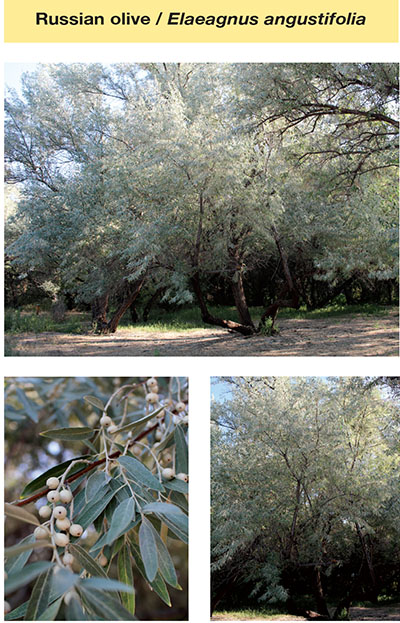
(Photos by Leslie Beck, NMSU.)
Class C
Russian olive / Elaeagnus angustifolia
Perennial tree or large shrub that infests grasslands, rangelands, woodlands, desert shrubland, and especially riparian areas, as well as disturbed areas, such as roadsides, ditches, and open fields.
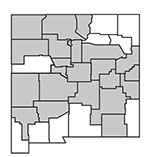
Also Known As: Oleaster
Stems/Leaves: One to six main stems or trunks (16–40 ft tall, 4–20 in. thick) with gray or brown bark, sometimes coarse or scaly; leaves (0.8–4 in. long, 0.5–1.5 in. wide) are alternate, entire, oblong to linear or lanceolate, dull to gray-green with a silvery underside.
Flowers: Flowers (0.12–0.5 in. long) grow in clusters at branch ends, have four yellow to white petals, and are fragrant.
Roots: Extensive root system with a root crown and creeping perennial roots.
Reproduction: From root crown, creeping perennial roots, or seed; most reproduction and spread occurs through seeds and creeping perennial roots.
Management Do’s and Don’ts
• Prevention and early detection are the most effective control methods.
• Mowing saplings and cutting or removing mature trees are all effective controls if repeated often.
• Herbicides are somewhat effective.
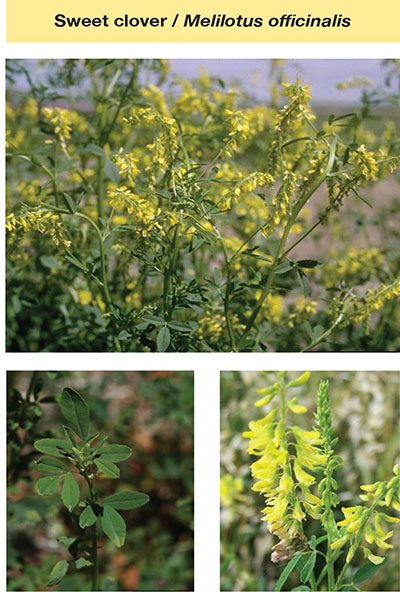
(Photos: top by Howard F. Schwartz, Colorado State University; bottom left by Chris Evans, University of Illinois; bottom right by Karan A. Rawlins, University of Georgia, all via Bugwood.org.)
Troublesome Weed
Sweet clover / Melilotus officinalis
Perennial sweet-smelling herbaceous weed commonly found in roadsides, waste spaces, floodplains, agricultural fields, and pristine areas.
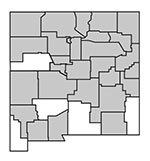
Also Known As: Yellow sweetclover
Stems/Leaves: Stems are arranged in a cluster of up to 10 per plant, erect (10–60 in. tall) and smooth; leaves alternate along the stems on short petioles, pinnately compound with 3 leaflets per leaf, oval in shape (<1.5 in. long) and slightly toothed.
Flowers: Flowers are yellow (<0.25 in. long), in racemes (<5.5 in. long), with pea-flower morphology (papilionaceous) and fade to a cream color at the base.
Roots: Taproot with short rhizomes.
Reproduction: Seed; successful management prevents seed production/spread. Rhizomes can aid in spread, but not extensively.
Management Do’s and Don’ts
• Physical removal before seed production for single plants/small infestations, removing the rhizomes as well.
• Herbicides are effective.
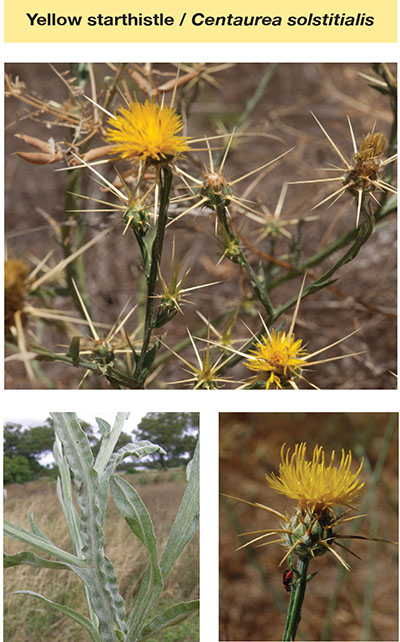
(Photos: top by Franco Folini; bottom left by Harry Rose; bottom right by Eugene Zelenko all via Creative Commons.)
Class A
Yellow starthistle / Centaurea solstitialis
Annual (occasionally biennial) that infests disturbed areas, such as roadsides and open fields, as well as rangelands, grasslands, open woodlands, pastures, and crop fields. Yellow starthistle is toxic to horses if consumed.
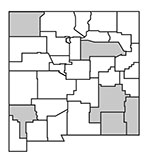
Also Known As: Golden starthistle, yellow cockspur, St. Barnaby’s thistle
Stems/Leaves: Stiff, wiry stems (1–6 ft tall) are often branched; leaves (1.5–6 in. long) are blue- to gray-green, densely covered with fine cotton-like hairs, alternate, linear to oblong in shape with smooth, toothed, or lobed margins; leaf bases extend down the stem creating wings (up to 0.2 in. wide).
Flowers: Flower heads (0.5–1.5 in. diameter) found singly at stem ends, oval or round with a yellow flower; several stiff, sharp, straw-colored bracts (0.75 in. long) are found beneath the flower.
Roots: Taproot
Reproduction: Seed; successful management prevents seed production/spread.
Management Do’s and Don’ts
• Prevention and maintenance of a healthy plant community are the best management methods.
• Frequent cultivation is effective.
• Mow plants in late bud or early bloom to reduce seed production.
• Burning is effective if done before seed production.
• Numerous effective biological control agents have been introduced.
• Herbicides are effective.
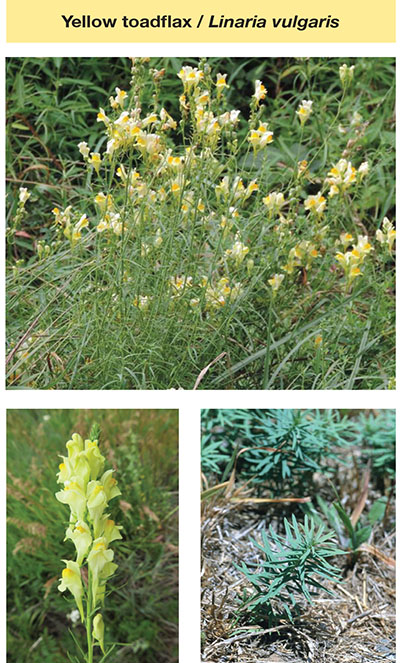
(Photos: top by Richard Gardner, Bugwood.org; bottom left by Leslie Beck, NMSU; bottom right by Joseph M. DiTomaso, University of California–Davis, Bugwood.org.)
Class A
Yellow toadflax / Linaria vulgaris
Herbaceous perennial that aggressively invades disturbed communities, such as roadsides, graded areas, abandoned lots, rangelands, and riparian communities.
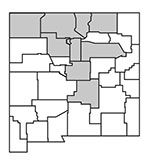
Also Known As: Butter and eggs, wild snapdragon, common toadflax
Stems/Leaves: Stems (1–3 ft tall) sometimes hairy, often branched near top, woody at the base and herbaceous at the top; leaves (1–2.5 in. long, 0.1–0.2 in. wide) are pale green, soft, linear in shape, and DO NOT clasp stem.
Flowers: Found in racemes at ends of stems; flowers (0.5–1.5 in long) are bright yellow or white, snapdragon-like with an orange bearded throat and a yellow spur.
Roots: Extensive creeping perennial root system.
Reproduction: Creeping perennial roots and seed reproduction.
Management Do’s and Don’ts
• Maintenance of a healthy plant community and prevention are the best management methods.
• Physical removal is effective if continually repeated for 5–15 years to deplete seed bank.
• Revegetation with competitive species is effective.
• Eight biological control agents have been approved for use.
• Herbicides are effective.
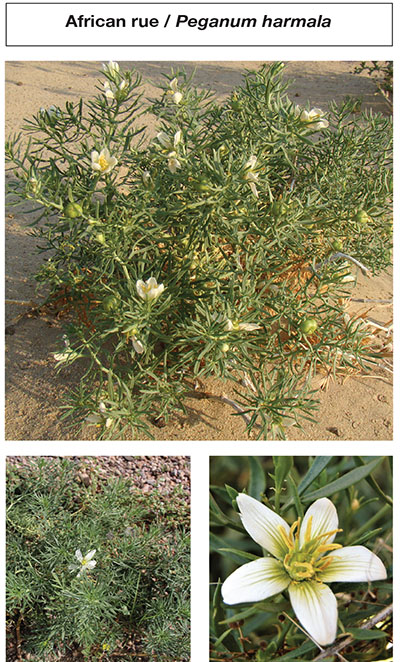
(Photos: top by Yuriy75, Creative Commons; bottom right by Beko, Creative Commons; bottom left by Leslie Beck, NMSU.)
Class B
African rue / Peganum harmala
Perennial that infests disturbed areas, such as roadsides, open fields, and ditches, as well as arid and semiarid desert areas. All parts of the plant are toxic to humans and livestock if ingested.

Also Known As: Harmal, isband, ozallaik, ruin weed
Stems/Leaves: Numerous dense, branching stems (not more than 1–1.5 ft tall); leaves (0.8–2 in. long) are bright green, fleshy, unevenly branched, linear, and glabrous.
Flowers: Five white, oblong petals (0.5 in. long); five green sepals (0.5 in. long) that resemble leaves are found below each flower; flowers grow at leaf axils along stem; produces round, three-chambered seed pods (0.25–0.6 in. in diameter) green, orange, or brown in color.
Roots: Woody taproot with creeping lateral roots that can develop shoot buds.
Reproduction: Root crown, perennial roots, or seed reproduction; reproduces primarily through seed.
Management Do’s and Don’ts
• Prevention and early detection are the most effective control methods.
• Physical removal is effective if most or all of the root system is removed.
• Herbicides are effective.
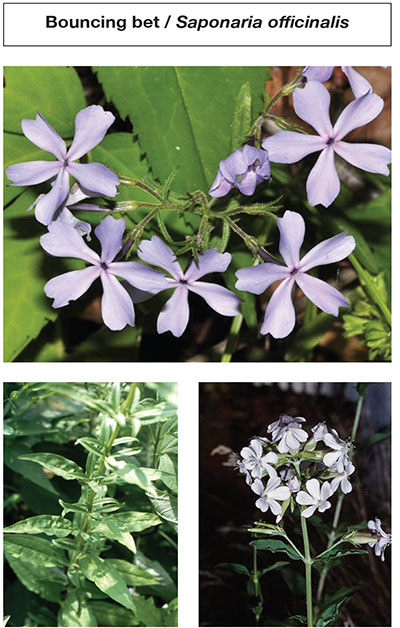
(Photos: bottom right by Joseph M. DiTomaso, University of California–Davis; top by William M. Ciesla, Forest Health Management International; bottom left by John Cardina, The Ohio State University, all via Bugwood.org.)
Troublesome Weed
Bouncing bet / Saponaria officinalis
Perennial forb with colonial (plants in an area are genetically identical) spread, commonly found in disturbed habitats, roadsides, streambanks, and disturbed fields.

Also Known As: Soapweed, soapwort, sweet Betty
Stems/Leaves: Stems are erect (10–35 in. tall), simple or sparsely branched, smooth and rhizomatous; leaves are cauline, opposite, simple, and can be elliptic, oblanceolate, or ovate in shape (3–4 in. long) with entire margins; leaf blades are sessile or with a small winged petiole.
Flowers: Flowers are clustered at stem tips at the end of branching pedicels; flowers are phlox-like and have five pink or white notched petals that are retroflexed with two appendages at the junction of the petal base and claw; sepals fuse together to form a smooth funnel-like calyx from which petals emerge.
Roots: Taproot and spreading rhizomes.
Reproduction: Creeping perennial roots and seed reproduction.
Management Do’s and Don’ts
• Maintenance of a healthy plant community and prevention are the best management methods.
• Physical removal is largely ineffective.
• Herbicides are effective.
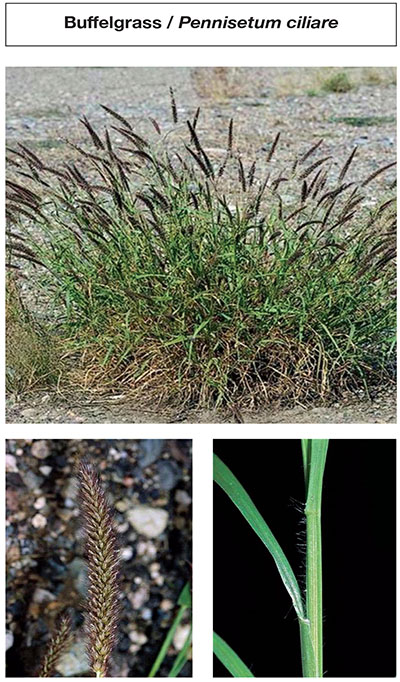
(Photos by Joseph M. DiTomaso, University of California–Davis, Bugwood.org.)
Watch List
Buffelgrass / Pennisetum ciliare
Perennial bunchgrass commonly found in disturbed habitats. Spreads very quickly on unmanaged or abandoned land.
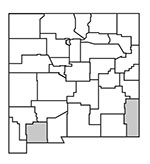
Also Known As: Buffel fountaingrass
Stems/Leaves: Perennial bunchgrass with erect stems (10–60 in. tall) forming thick mats or tussocks from a hard, knotty base with extensive tillers; sheaths are scabrous, ciliate laterally near the ligule, with blueish-green blades (1–11 in. long); ligule is densely ciliate; the lower membranous portion is very short.
Flowers: Inflorescence is purplish to reddish in color, with bottlebrush-like spikelets in clusters of 5–10 per plant; each spikelet has two flowers with the lower floret reduced or smaller, and can range in color from tan to beige or even slightly orange at maturity; seeds spread when whole spikelets fall from the rachis to the ground when mature.
Roots: Fibrous
Reproduction: Generally by seed production (apomictic: asexual reproduction without fertilization of a seed).
Management Do’s and Don’ts
• Prevention and early detection are the most effective control methods.
• Continual prevention of seed production and spread is effective at reducing the seedbank.
• Physical removal is effective if most or all of the root system is removed, but may actually serve to facilitate further invasion and spread.
• Herbicides are effective.
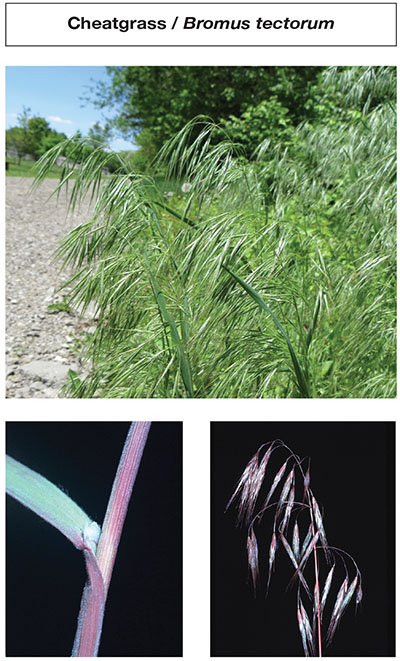
(Photos: top by Leslie Beck, NMSU; bottom left and right by Joseph M. DiTomaso, University of California–Davis, Bugwood.org.)
Class C
Cheatgrass / Bromus tectorum
Annual grass that infests disturbed areas, such as roadsides, open fields, and ditches, as well as crop fields, rangelands, grasslands, and desert areas.
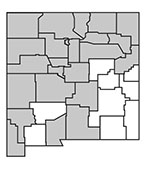
Also Known As: Downy or drooping brome, military grass, June grass, bronco grass
Stems/Leaves: Narrow stems (1–24 in. long) often droop; leaves (several inches long, 0.05–0.25 in. wide) are green to purple with closed sheaths that extend at least halfway down the stem, with some long hairs on sheaths and leaf base.
Flowers: Multiple, slightly flattened grass spikes (2.5–8.5 in. long) are found at the ends of thin stems and often droop; each spike has 4–8 seeds (0.3–0.5 in. long) and each seed is tipped with a stiff bristle (0.3–0.7 in. long); spikes and seeds are green to purple or red in color.
Roots: Fibrous root system.
Reproduction: Seed; successful management prevents seed production/spread.
Management Do’s and Don’ts
• Maintenance of a healthy plant community and prevention are the best management methods.
• Burning before seed dispersal will destroy seed but may leave the site susceptible to re-invasion in following years.
• Mowing within a week after flowering will reduce seed production.
• Herbicides are effective.
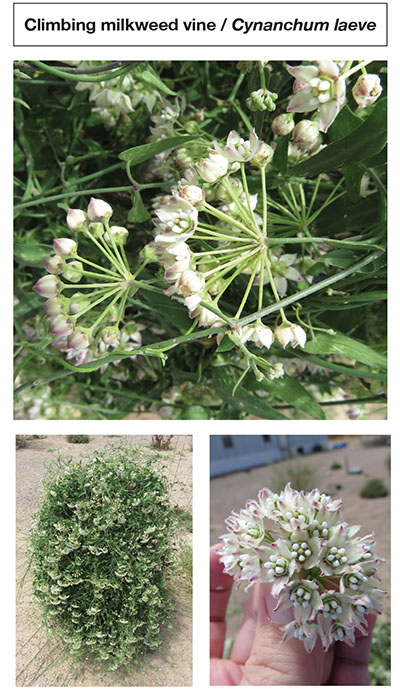
(Photos by Leslie Beck, NMSU.)
Troublesome Weed
Climbing milkweed vine / Cynanchum laeve
Perennial herbaceous vine commonly found in disturbed soils and cultivated fields, waste grounds, landscapes, or along railroads and roadsides.
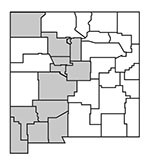
Also Known As: Honeyvine
Stems/Leaves: Vine-like growth and spread, with stems that are twining, climbing, smooth, and green in color, although sometimes stems can appear reddish; if the stem is damaged or cut it exudes a milky (latex) sap that can me mildly toxic if ingested; leaves are opposite, long stalked (petioled), heart-shaped with entire margins and a long-pointed/tapered tip.
Flowers: Vines can produce over twenty flowers in one long-stalked, umbel-like cluster; each flower is white, radially symmetrical with a whorl of extra appendices between the petals and stamens called a crown or corona; each flower has five petals that are fused at the base, then separating into erect or ascending, greenish-white, lance-shaped lobes with pointed tips.
Roots: Extensive taproot.
Reproduction: Seed; successful management prevents seed production/spread.
Management Do’s and Don’ts
• Prevention and early detection are the most effective control methods.
• Continual prevention of seed production through removal of pods prior to maturity is effective at reducing the seedbank.
• Physical removal is effective if most or all of the root system is removed.
• Herbicides are effective.
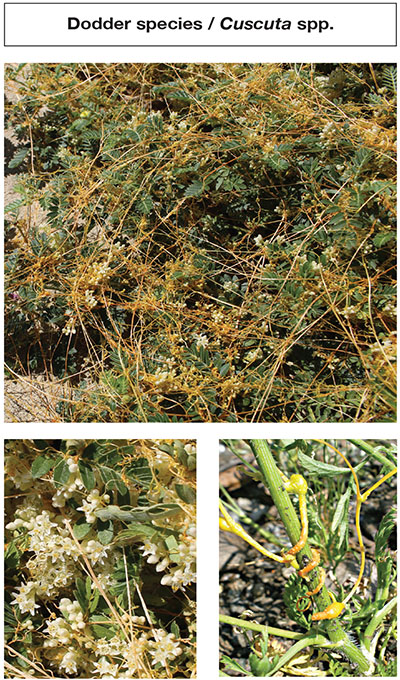
(Photos: top and bottom left by Leslie Beck, NMSU; bottom right by Ansel Oommen, Bugwood.org.)
Troublesome Weed
Dodder species / Cuscuta spp.
Generally an annual wholly parasitic herbaceous vine, although it can be a short-lived perennial if on a perennial host, that is commonly found on a variety of native and introduced plants. Many species of Cuscuta parasitize select groups of plant families or genera, but some species are more general in their host selection.
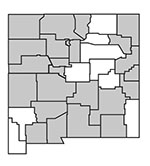
Also Known As: Cuscuta spp.
Stems/Leaves: The plant is not in contact with the ground, but instead is attached to its host plant by many small specialized roots (haustoria) distributed along the stem; stems are thread-like and can range in many different colors, including yellow, orange, red, and occasionally green; leaves are usually absent or can be scale-like, distributed alternatingly along the stem.
Flowers: Flowers are tiny and whitish, clustered in lateral cymes with petals that are always fused together, corolla-shaped (tubular to bell- or urn-shaped), and usually white or cream in color.
Roots: No roots; haustoria penetrate and invade the tissue of the host.
Reproduction: Seed; successful management prevents seed production/spread.
Management Do’s and Don’ts
• Prevention and early detection are the most effective control methods.
• Removal of the entire infected host plant prior to seed production can help with management.
• Herbicides are generally not effective since the plant is parasitic; however, some preemergent herbicide active ingredients have been observed to prevent seedling emergence.
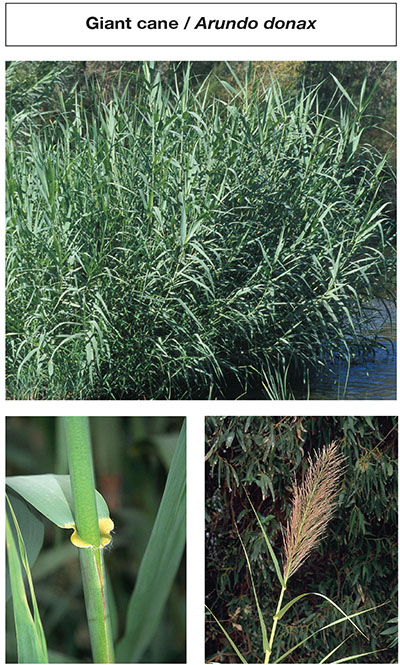
(Photos by Joseph M. DiTomaso, University of California-Davis, Bugwood.org)
Class C
Giant cane / Arundo donax
Bamboo-like perennial grass that infests riparian areas, floodplains, and irrigation ditches.
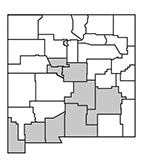
Also Known As: Giant reed, bamboo reed, elephant grass, wild cane
Stems/Leaves: Semi-woody, inflexible stems (up to 24 ft tall, 0.5–1.5 in. thick) are hollow except at nodes, often branched at the base; leaves (1–3 ft long, 1–3 in. wide) are flat with rough margins, lanceolate with a sharp tip; leaf bases are broad, have long hairs, and clasp stem, often yellow to green in color.
Flowers: Plume-like panicles (1–2 ft long) are cream to purple or brown in color, with numerous fine branches.
Roots: Large creeping and branching rhizome system.
Reproduction: Vegetative reproduction from rhizomes, root crowns, and stem fragments.
Management Do’s and Don’ts
• Physical removal must remove rhizomes and stem fragments.
• Herbicides are effective, especially when used in conjunction with cutting.
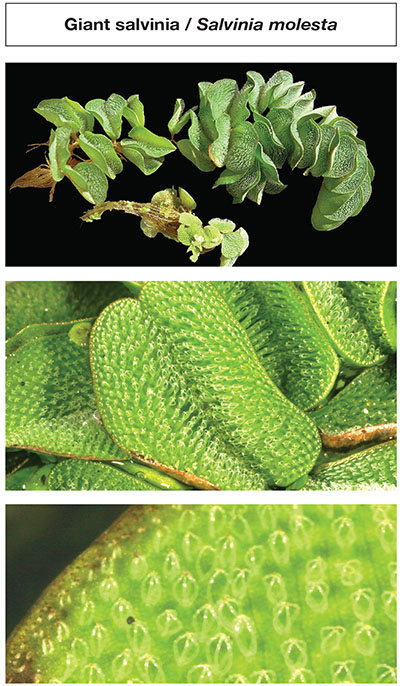
(Photos by Barry Rice, sarracenia.com, Bugwood.org.)
Class A
Giant salvinia / Salvinia molesta
Perennial aquatic fern that infests riparian areas with a still or slow-moving flow, such as lakes, ponds, reservoirs, rivers, streams, or irrigation ditches.

Also Known As: Aquarium watermoss, butterfly fern, karibaweed, koi kandy
Stems/Leaves: Simple to heavily branched stems of varying length; leaves (1–2.5 in. long) may be on or below water surface and are flat, oval, surfaces densely covered with “eggbeater”-shaped hairs (0.08–0.16 in. long); submersed leaves are brown, pinnate-divided, and resemble roots.
Flowers: Ferns lack true flowers; some submerged leaves can develop chains or groups of spores (0.04–0.12 in. diameter) that are not viable.
Roots: Lacks true roots; submerged leaves look like fine, white root-like filaments (up to 0.8 in. long).
Reproduction: Vegetative reproduction from stem fragments.
Management Do’s and Don’ts
• Physical removal is effective if all plant fragments are removed.
• Removing stem fragments and plant parts from boats, lines, and fishing gear can help prevent spread of infestations.
• Herbicides are effective.

(Photos by Leslie Beck, NMSU.)
Class B
Halogeton / Halogeton glomeratus
Annual that infests open, disturbed areas, such as roadsides, open fields, and especially arid or semiarid areas; adapted to soils with high alkalinity or salt content. All parts of the plant are toxic to livestock if ingested, especially sheep.
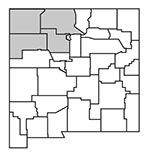
Also Known As: Barilla, saltlover
Stems/Leaves: Stems (2–18 in. tall) are branched at the base, usually erect but sometimes spreading, often shaded purple or red; leaves (0.15–0.85 in. long, 0.04–0.08 in. wide) alternate, dull green to blue-green, look like fleshy cylinders with a stiff bristle (approx. 0.05 in. long) at the tip.
Flowers: Found in dense bunches at leaf axils; flowers lack true petals but have five sepals, each with a fan-like tip (0.08–0.12 in. long), greenish-yellow to red in color with conspicuous veins.
Roots: Taproot
Reproduction: Seed; successful management prevents seed production/spread.
Management Do’s and Don’ts
• Physical removal is effective for small infestations.
• Revegetation with desirable perennials is an effective management technique because halogeton is a poor competitor.
• Herbicides are effective.
• DO NOT use fire—it creates favorable conditions for growth.
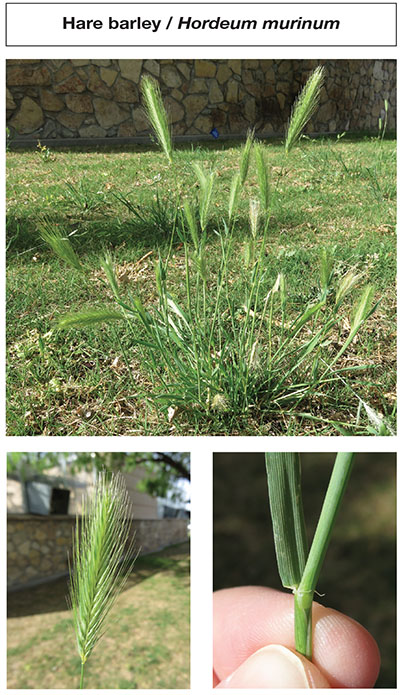
(Photos by Leslie Beck, NMSU.)
Troublesome Weed
Hare barley / Hordeum murinum
Annual bunch-type grass that infests disturbed areas, such as roadsides, rangelands, pastures, agricultural fields, landscapes, ditch banks, and waste spaces.
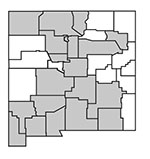
Also Known As: Hordeum murinum L. ssp. leporinum, mouse barley, wall barley, bulbous barley
Stems/Leaves: Stems are erect or ascending, tufted or clustered, rounded in cross-section, nodes are often swollen; stems grow somewhat spreading with multiple tillers and often bend abruptly at the base; leaves are flat, rolled in the bud, and are generally covered in short hairs; collar features include papery ligules, and unlike the similar-looking foxtail barley, very well-developed, long, narrow auricles that clasp the stem.
Flowers: Inflorescence head is a bristly, dense spike (1–3 in. long); at maturity, it breaks into several pieces; flowers bloom from April through June, and the spikelet is distinctive because it features very long and even-length awns.
Roots: Fibrous root system.
Reproduction: Seed; successful management prevents seed production/spread.
Management Do’s and Don’ts
• Maintenance of a healthy plant community and prevention are the best management methods.
• Physical removal can be effective due to its shallow root system and bunch-type growth.
• Burning before seed dispersal will destroy seed but may leave the site susceptible to re-invasion in following years.
• Mowing within a week after flowering will reduce seed production.
• Herbicides are effective.

(Photos: top by George Beck and James Sebastian, Colorado State University; middle and bottom by Joseph M. DiTomaso, University of California–Davis, all via Bugwood.org.)
Class A
Hoary cress species / Cardaria spp.
Perennial that infests moist areas, such as irrigated pastures, rangelands, hay fields, and other crop fields; also infests disturbed sites, such as roadsides, railways, and ditches. Three species occur in New Mexico: lens-podded hoary cress (C. chalapensis), heart-podded hoary cress (C. draba), and globe-podded hoary cress (C. pubescens); heart-podded is most common. All three species are included under hoary cress species (Cardaria spp.) on the NM Noxious Weeds List. Some botanists place these plants in the genus Lepidium with the same species names (L. chalapensis, L. draba, L. pubescens).
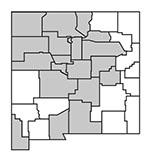
Also Known As: Lepidium spp., whitetop, little whitetop, hairy whitetop
Stems/Leaves: Mostly single stems (6–24 in. tall) are hairy with some branching near top; leaves (0.5–4 in. long, 0.1–1.5 in. wide) are alternate, gray-green, oblong to narrow in shape, sometimes hairy, with entire to toothed margins; upper leaves clasp stem.
Flowers: Numerous small, white, fragrant flowers with four petals (0.08–0.16 in. long) form rounded or flat-topped inflorescences at stem ends; seed pods (0.1–0.2 in. long and wide) are round, oval, or heart-shaped, light green to brown, with a short projection (0.04–0.08 in. long).
Roots: Extensive creeping perennial root system.
Reproduction: Perennial roots and seed reproduction.
Management Do’s and Don’ts
• Physical removal must remove root system.
• Repeated cultivation 1–2 times per month for 2–4 years is effective.
• Mowing at early flower growth stage may lower stem density and reduce seed production.
• Herbicides are effective.

(Photos: top and middle by Leslie J. Mehrhoff, University of Connecticut; bottom by Raghavan Charudattan, University of Florida, all via Bugwood.org.)
Class C
Hydrilla / Hydrilla verticillata
Aquatic perennial that infests riparian areas with a still or slow-moving current, such as lakes, ponds, reservoirs, rivers, streams, and irrigation ditches.
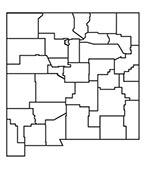
Also Known As: Florida elodea, waterthyme
Stems/Leaves: Stems are green to brown, length varies with environmental conditions; leaves (0.25–0.8 in. long, 0.04–0.16 in. wide) are linear or lanceolate, 2–8 whorled with toothed margins.
Flowers: Three sepals or petals (0.12–0.2 in. long), white to reddish; sometimes produces reproductive structures called turions (0.12–0.5 in. long) at leaf axils, dark green, mostly conical.
Roots: Slender, un-branched, submerged roots may form dense mats.
Reproduction: Root structures, stem fragments, and turions.
Management Do’s and Don’ts
• Physical removal is effective if all plant fragments are removed.
• Removing stem fragments and plant parts from boats, lines, and fishing gear can help prevent spread of infestations.
• Herbicides may be effective.
• Sterile grass carp can be an effective biological control.
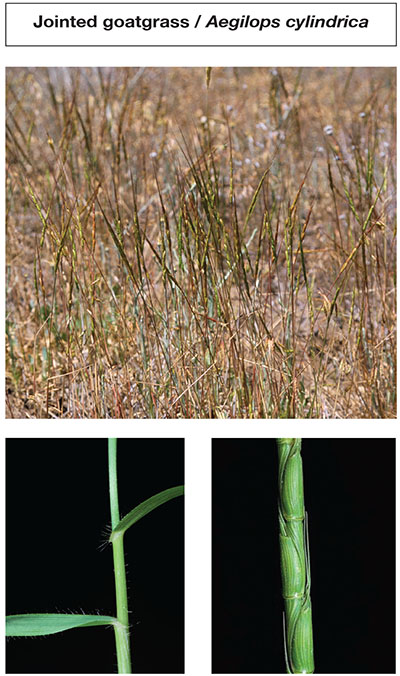
(Photos by Joseph M. DiTomaso, University of California–Davis, Bugwood.org.)
Class C
Jointed goatgrass / Aegilops cylindrica
Winter annual grass that infests disturbed areas, such as agricultural fields, grasslands, and roadsides.
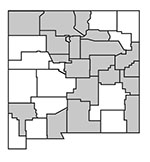
Also Known As: Aegilops caudate, Aegilops tauschii
Stems/Leaves: Plants grow up to 2 ft tall with hollow stems; leaves (>5 in. long) alternate, with membranous ligules, rounded auricles, and hairy margins.
Flowers: Inflorescences are cylindrical spikes and disperse as units until maturity, but eventually break apart into joints (spikelets) over time; spikelets are cylindrical and consist of 2–5 florets, the lower two are fertile, and the uppermost florets are sterile.
Roots: Fibrous roots.
Reproduction: Seed; successful management prevents seed production/spread.
Management Do’s and Don’ts
• Prevent seed production.
• Herbicides are effective.
• Tillage and physical removal are effective.
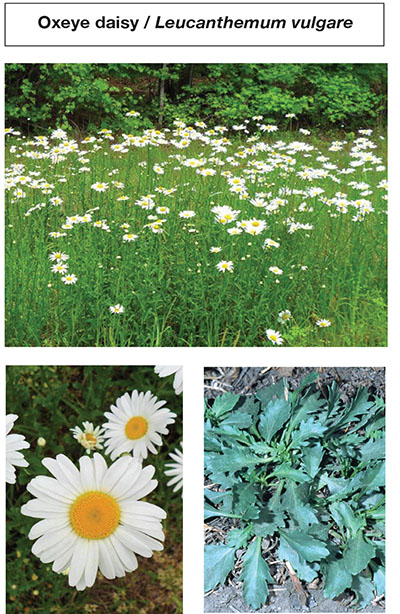
(Photos: top and bottom left by David Stephens; bottom right by Joseph M. DiTomaso, University of California–Davis, all via Bugwood.org.)
Class A
Oxeye daisy / Leucanthemum vulgare
Perennial found in a variety of habitats, including rangelands, grasslands, roadsides, open fields, ditches, and other disturbed areas; grows well in poor soils.
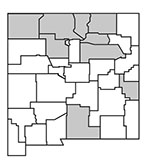
Also Known As: Butter daisy, golden flower, Chrysanthemum leucanthemum
Stems/Leaves: Stems (up to 3 ft tall) are often clumped together, little to no branching; leaves (2–6 in. long) are lanceolate, pinnate-divided, green to dark green, alternate.
Flowers: Single flower on each stem (1–40 stems per plant); flowers (1.2–2.75 in. in diameter) have numerous white petals (0.4–0.8 in. long) surrounding a yellow center.
Roots: Extensive creeping perennial root system.
Reproduction: Perennial roots, root fragments, and seed reproduction.
Management Do’s and Don’ts
• Physical removal must remove root system.
• Cultivation in summer to a depth of 6 in. followed by repeated shallow cultivation is effective at destroying roots and seedlings.
• Herbicides are effective.
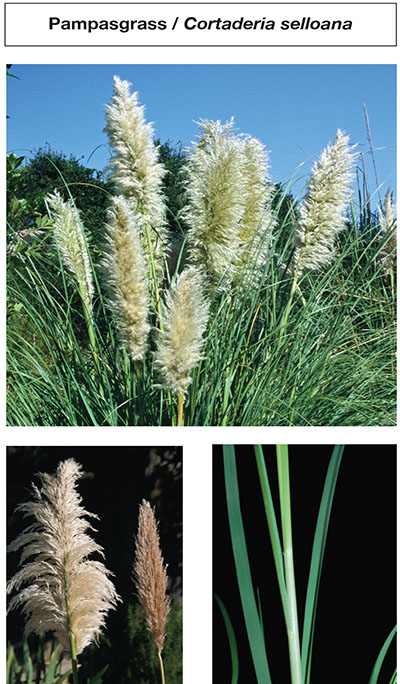
(Photos by Joseph M. DiTomaso, University of California–Davis, Bugwood.org.)
Watch List
Pampasgrass / Cortaderia selloana
Perennial that infests disturbed areas, undisturbed shrubland and marshes, riparian areas, and other sites where moisture is available.
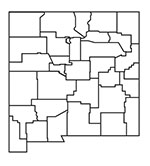
Also Known As: Common pampasgrass, Uruguayan pampasgrass, silver pampasgrass
Stems/Leaves: Plants grow in large clumps called tussocks (up to 12 ft tall) with an erect and fountain-like appearance; leaves basal, flat or folded, with a bluish-green color and sharply serrated margins; sheaths open, glabrous to hairy, ligules consist of a dense ring of hairs (0.08–0.182 in. long).
Flowers: Male and female flowers generally develop on separate plants with plume-like inflorescences (1–3 ft long); female plumes are white with stiff secondary branches; male plumes are sometimes tinted purplish with flexible secondary branches.
Roots: Dense fibrous roots with short lateral rhizomes.
Reproduction: Seed; successful management prevents seed production/spread.
Management Do’s and Don’ts
• Manually cutting from below the crown is effective.
• Herbicides are effective.
• Heavily mulching or planting desirable vegetation is effective.

(Photos: top by Leslie J. Mehrhoff, University of Connecticut; bottom by Alison Fox, University of Florida both via Bugwood.org.)
Class C
Parrotfeather / Myriophyllum aquaticum
Aquatic perennial that infests riparian areas, such as lakes, ponds, rivers, streams, and irrigation ditches; usually found in still or slow-moving water, but occasionally in fast-moving streams or rivers.

Also Known As: Brazilian watermilfoil, thread-of-life
Stems/Leaves: Immersed stems (up to 15 ft long, 0.2 in. in diameter) may be branched, gray-green to reddish; leaves (0.5–1.5 in. long) 5–6 whorled, pinnate-divided with 10–15 pairs of opposite or alternate lobes (up to 0.3 in. long); lobes are linear and the main leaf axis is broader than the lobes.
Flowers: Tiny flowers with translucent white petals or sepals (0.05–0.15 in. long) found at middle or upper leaf axils.
Roots: Numerous creeping, branched rhizomes that form large, thick surface or subsurface mats.
Reproduction: Vegetative reproduction from rhizomes, stem fragments, or buds on leaf axils.
Management Do’s and Don’ts
• Repeated mechanical removal is effective at controlling density, but stem fragments may escape and form new infestations.
• Removing stem fragments and plant parts from boats, lines, sand fishing gear can help prevent spread of infestations.
• Herbicides are effective.
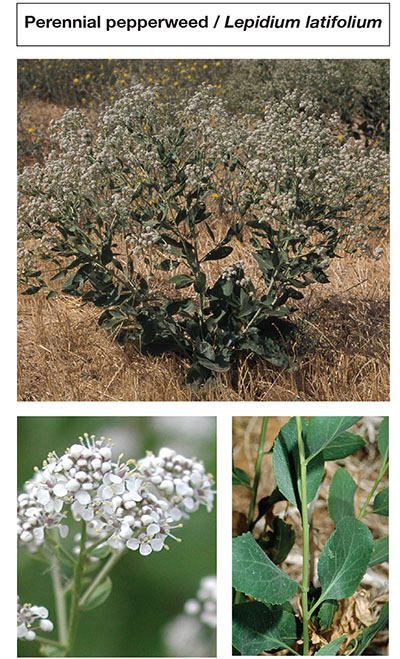
(Photos: top and bottom right by Joseph M. DiTomaso, University of California–Davis; bottom left by Leslie J. Mehrhoff, University of Connecticut, all via Bugwood.org.)
Class B
Perennial pepperweed / Lepidium latifolium
Creeping herbaceous perennial found mostly in riparian areas, irrigation ditches, floodplains, and wetlands.
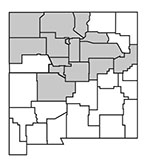
Also Known As: Tall whitetop, peppergrass
Stems/Leaves: Numerous semi-woody stems (2–5 ft tall) are glabrous, waxy, with some branching near the top; leaves (4–11 in. long, 1–3 in. wide) are green to gray-green, oval to narrow in shape, glabrous, alternate, and DO NOT clasp stem; basal leaves have serrate margins, stem leaves are entire to serrate.
Flowers: Small, white flowers with four petals (0.15 in. long) form dense inflorescences that are rounded on top.
Roots: Creeping perennial root system; white to cream color with distinct odor.
Reproduction: Perennial roots, root fragments, and seed reproduction.
Management Do’s and Don’ts
• Maintenance of a healthy plant community and prevention are the best management methods.
• Hand pull all roots and seedlings.
• Mowing is not an effective control method, but can prevent seed formation if done before flowering.
• Herbicides are effective.
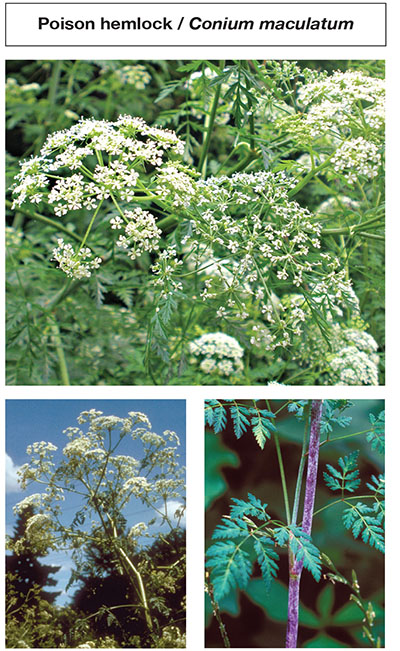
(Photos: top by Ansel Oomenn; bottom left by Eric Coombs, Oregon Department of Agriculture; bottom right by Ohio State Weed Lab, The Ohio State University, all via Bugwood.org.)
Class B
Poison hemlock / Conium maculatum
Biennial (sometimes annual or short-lived perennial) that typically infests open fields, pastures, ditches, riparian areas, and crop fields. All parts of the plant are extremely toxic to humans and livestock. All parts of the plant can cause mild to severe dermatitis upon contact with sensitive skin.
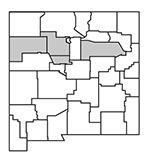
Also Known As: Deadly hemlock, spotted hemlock, poison parsley, poison stinkweed
Stems/Leaves: Stems (up to 10 ft tall) are hollow except at the nodes, ribbed, often with purple or reddish spotting or streaking, but sometimes without streaking; leaves (4–12 in. long) are triangular, glabrous, and pinnate-divided with toothed leaflets.
Flowers: Several inflorescences grow in small bunches with a single axis; flowers are very small and white.
Roots: Taproot
Reproduction: Seed; successful management prevents seed production/spread.
Management Do’s and Don’ts
• Hand pulling or cutting below the root crown is effective for small infestations.
• Repeated cultivation or mowing (before seed production) is effective for controlling large infestations.
• Herbicides are effective.
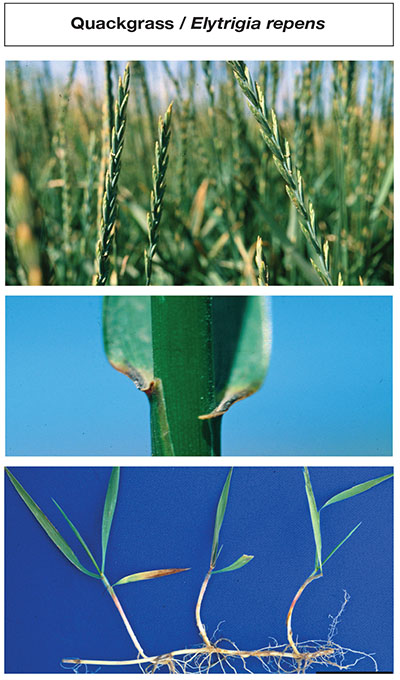
(Photos by Steve Dewey, Utah State University, Bugwood.org.)
Class B
Quackgrass / Elytrigia repens
Tufted perennial grass that infests disturbed areas, such as roadsides, ditches, open fields, and urban areas, as well as crop fields.
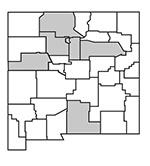
Also Known As: Elymus repens, couchgrass, devil’s grass, dog grass, quickgrass, twitchgrass, wiregrass
Stems/Leaves: Round grass-like stems (up to 3.5 ft tall) with swollen nodes; flat, drooping leaves (1.6–12 in. long, 0.08–0.55 in. wide) are green to blue-green, have ribbed veins with large spaces between veins, and open sheaths; leaf blades have a constriction near tip.
Flowers: Produces grass seeds on an elongated stem (2–8 in. long); seeds (0.35–0.6 in. long) alternate along the stem.
Roots: Large perennial creeping and branching rhizome system, often with a tough brown covering.
Reproduction: Rhizome and seed reproduction.
Management Do’s and Don’ts
• Maintenance of a healthy plant community and prevention are the best management methods.
• Cultivation is effective but must be repeated to ensure that all rhizomes are destroyed.
• Herbicides are effective.

(Photos by Joseph M. DiTomaso, University of California–Davis, Bugwood.org.)
Class A
Ravennagrass / Saccharum ravennae
Perennial that infests the margins of riparian zones, marshes, and ditches.
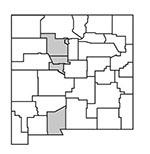
Also Known As: Ravenna grass, hardy pampasgrass, plume grass
Stems/Leaves: Very tall, erect ornamental grass that forms clumps (9–13 ft tall, 4–6 ft wide); flowering stems (up to 13 ft tall) with leaves distributed on the flowering stems up to the base of the inflorescence; leaves are densely covered with long, fuzzy, brown hairs at the base that hide the ligules and the upper surface of the blade base.
Flowers: Silky-hairy spikelets in unequal pairs; lower spikelet is sessile, upper spikelet is stalked; each spikelet consists of two florets, upper floret is fertile, lower floret is sterile.
Roots: Fibrous root system.
Reproduction: Seed; successful management prevents seed production/spread.
Management Do’s and Don’ts
• Mowing and burning are NOT effective.
• Removing the roots is effective.
• Herbicides are effective.

(Photos by Joseph M. DiTomaso, University of California–Davis, Bugwood.org.)
Troublesome Weed
Scarlet beeblossom / Gaura coccinea
Perennial herb that is native to the Southwest; however, has been reported as invasive in plains, hills, riparian areas, agricultural fields, and landscapes.
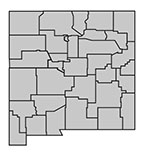
Also Known As: Oenothera suffrutescens, scarlet evening-primrose, scarlet gaura
Stems/Leaves: Stems (up to 15 in. tall) emerge from a woody base, are clumped together, and can branch out below or above the ground; when branching below the ground, the resulting horizontal stems may give rise to new plants; leaves are alternate and sessile along the stems; blades are linear to narrowly elliptic with entire to coarsely wavy-serrate margins.
Flowers: Small but showy, and slightly asymmetrical; flowers are arranged in erect, dense clustered spikes; flowers at the base of spikes open first and can be pinkish, red, or white in color with four petals, red-tipped anthers, and four downward curving sepals that are pinkish-green.
Roots: Taproot, and possible spreading belowground stems (though not truly rhizomatous).
Reproduction: Seed; successful management prevents seed production/spread.
Management Do’s and Don’ts
• Physical removal is effective for small infestations.
• Prevent the production and spread of viable seed if planted as a desirable landscape plant.
• Herbicides are effective.
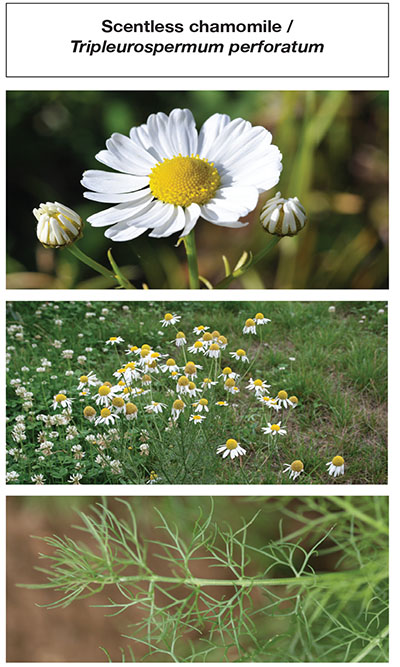
(Photos: top by Aiwork; middle and bottom by Oceancetaceen–Alice Chodura-Natalie Schmaiz, all via Creative Commons.)
Class A
Scentless chamomile / Tripleurospermum perforatum
Short-lived perennial, but can be an annual or biennial, herbaceous plant that is commonly found in disturbed soils in waste spaces, roadsides, rangelands, pastures, landscapes, and agricultural fields.
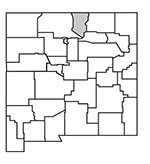
Also Known As: Tripleurospermum inodorum
Stems/Leaves: Stems are erect (6–36 in. tall) with numerous branches, may be reddish, smooth, and, unlike other species in the same genus, the whole plant is virtually without odor; leaves are very finely divided and fern/carrot-like, alternatingly arranged along the length of the stem.
Flowers: Flowers are white and daisy-like, solitary on each pedicle, and have an indeterminate flowering habit, meaning flowers and seed are continually developed and formed throughout the growing season.
Roots: Extensive fibrous root system.
Reproduction: Seed; successful management prevents seed production/spread.
Management Do’s and Don’ts
• Prevention of the spread of viable seed is effective.
• Physical removal is effective for small infestations.
• Repeated cultivation or mowing (before seed production) is effective for controlling large infestations.
• Herbicides are effective.
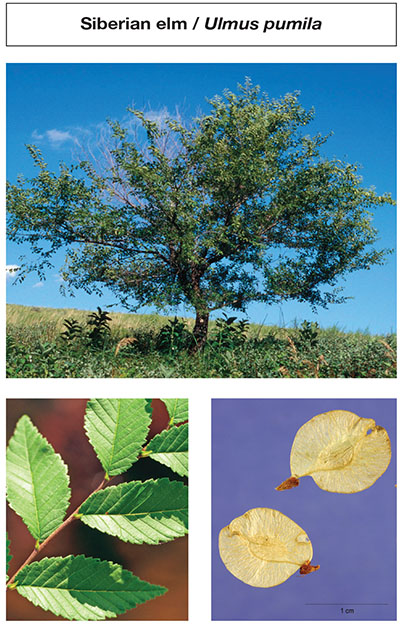
(Photos: top by John M. Randall, The Nature Conservancy; bottom left by Steve Dewey, Utah State University; bottom right by Steve Hurst, USDA NRCS PLANTS Database, all via Bugwood.org.)
Class C
Siberian elm / Ulmus pumila
Deciduous tree that invades rangelands, grasslands, pastures, semiarid areas, and riparian areas, as well as disturbed areas, such as roadsides, ditches, and open fields.
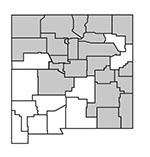
Also Known As: Dwarf elm, Asiatic elm
Stems/Leaves: Woody trunk (10–60 ft tall) has light or dark gray bark with numerous ridges or furrows; produces numerous branching stems; leaves (0.75–3 in. long, 0.3–1 in. wide) are alternate, oval to oblong, green to dark green, with serrate margins.
Flowers: Small, inconspicuous flowers grow in drooping clusters, lack petals, and are greenish with many small stalks that each bear a single flower; seed pods (0.5 in. in diameter) are thin, papery, green to brown, round or oval, with a deep notch at the tip.
Roots: Deep and extensive root system.
Reproduction: From root crown or from seed; most reproduction and spread occurs through seed.
Management Do’s and Don’ts
• Physical removal is effective for seedlings or small trees.
• Girding is effective for mature trees if performed properly.
• Herbicides are effective.
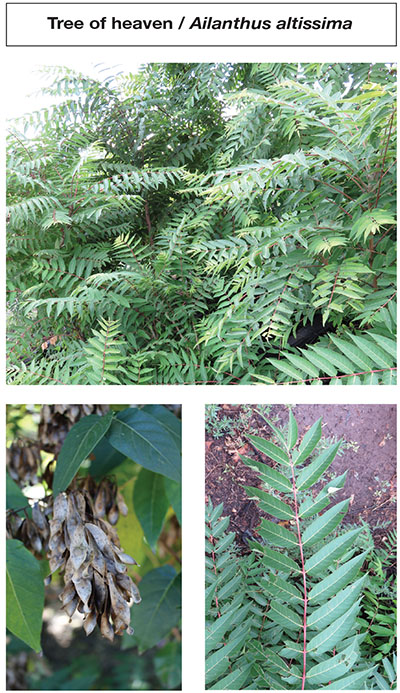
(Photos by Leslie Beck, NMSU.)
Class C
Tree of heaven / Ailanthus altissima
Deciduous tree that can tolerate shade, pollution, and harsh soil conditions; typically infests disturbed areas, such as roadsides, ditches, and waste areas, as well as natural sites such as riparian areas and woodlands.
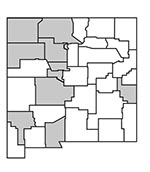
Also Known As: Ailanthus, copal tree, varnish tree
Stems/Leaves: Erect tree with a single trunk (up to 65 ft tall); small trees have smooth, gray-brown bark while larger trees have rough bark with diamond-shaped fissures; pinnate-divided leaves (1–3 ft long) have 10–22 pairs of opposite leaflets and one terminal leaflet; leaflets (3–5 in. long) are lanceolate with mostly smooth margins except for 2–4 rounded teeth at the base, often with small, circular glands on undersides of leaflets; leaves have a skunky odor when crushed.
Flowers: Develop in bunches 4–8 in. long; flowers are small, greenish-yellow to white with five petals; seed pods (1–2 in. long, 0.5 in. wide) are flat, constrict around a single seed, straw-colored to reddish-brown, and grow in bunches.
Roots: Taproot with shallow, creeping perennial lateral roots.
Reproduction: Root crown, lateral roots, and seed.
Management Do’s and Don’ts
• Maintenance of a healthy plant community and prevention are the best management methods.
• Physical removal is effective only if root crown and creeping lateral roots are removed.
• Herbicides are effective.
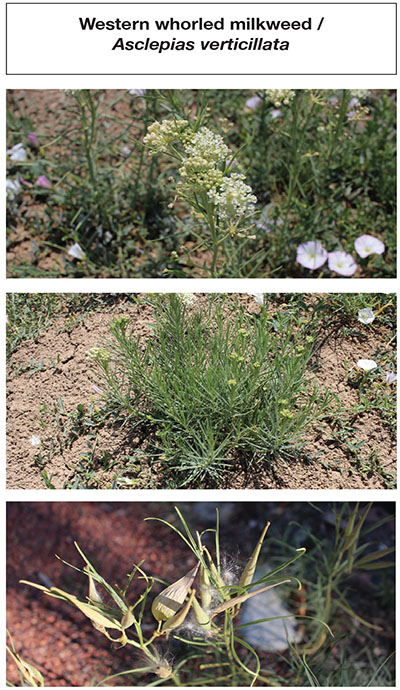
(Photos by Leslie Beck, NMSU.)
Troublesome Weed
Western whorled milkweed / Asclepias verticillata
Perennial herbaceous plant that is commonly found in disturbed soil sites, such as disturbed prairies, roadsides, waste spaces, riparian areas, rangelands, pastures, landscapes, and agricultural fields. All parts of the plant are toxic to all classes of livestock, especially horses.
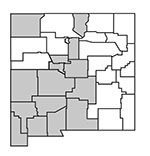
Also Known As: Asclepias subverticillata (Gray) Vail
Stems/Leaves: Stems are more or less erect (6–24 in. tall), either unbranched or sparingly branched along the upper half of the primary central stem; central stem is yellow-green in color and has vertical lines of short bristly hairs; leaves occur along the nodes of the central stem in whorls of 4–6 leaves (2–3 in. long); leaf margins are entire and strongly revolute (rolled downward).
Flowers: Each flower is <1 in. long and wide and consists of five sepals, five petals, and five hoods with horns and a central reproductive column; petals are white or greenish-white, sometimes with pale purplish tints toward their tips.
Roots: Fibrous root system with spreading rhizomes.
Reproduction: Rhizome and seed reproduction.
Management Do’s and Don’ts
• Multiple insects feed naturally on the plant.
• Physical removal is effective for small infestations if rhizomes are removed.
• Repeated cultivation or mowing are ineffective due to rhizomes.
• Herbicides are effective.
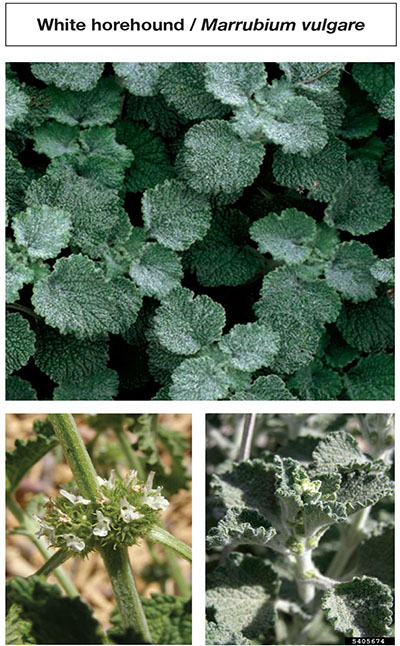
(Photos: top by Barry Rice, sarracenia.com; bottom left and right by Bonnie Million, Bureau of Land Management, all via Bugwood.org.)
Troublesome Weed
White horehound / Marrubium vulgare
Perennial herbaceous plant that is commonly found in disturbed sites, such as roadsides, ditch banks, rangelands, pastures, and agricultural fields.
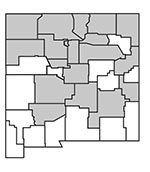
Also Known As: Horehound
Stems/Leaves: Produces several stems that are prostrate to ascending-erect (7–40 in. long/tall), densely white with soft wooly hairs; leaves are opposite (<5 in. long), conspicuously wrinkled, ovate to round, and have crenate margins; leaves appear green and pubescent from above, white and wooly from below.
Flowers: Flowers are whorled in globular clusters in leaf axils, with spiny calyxes and corolla shapes, whitish in appearance.
Roots: Taproot with numerous fibrous laterals.
Reproduction: Seed; successful management prevents seed production/spread.
Management Do’s and Don’ts
• Deep cultivation may help with control but may not be practical; mowing before seed formation can help prevent spread.
• Grazing is not generally effective.
• Prescribed burning can kill mature plants but may stimulate seed germination.
• Herbicides are effective.
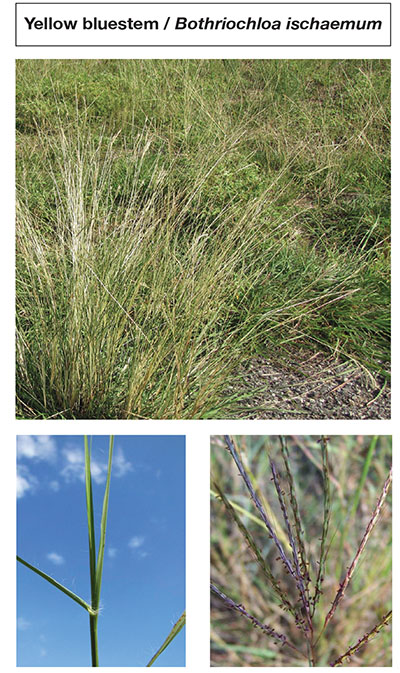
(Photos: top and bottom left by Michelle Villafranca, Fort Worth Nature Center & Refuge; bottom right by Karan A. Rawlins, University of Georgia, all via Bugwood.org.)
Watch List
Yellow bluestem / Bothriochloa ischaemum
Perennial graminoid that can often be found in disturbed areas, such as roadsides, ditch banks, rangelands, pastures, and agricultural fields.
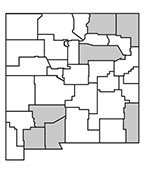
Also Known As: Bothriochloa ischaemum (L.) Keng var. songarica, King Ranch bluestem, Turkestan beard grass
Stems/Leaves: Cespitose perennial, occasionally stoloniferous to rhizomatous under grazing pressure; stems can be stiffly erect (12–30 in. tall) with glabrous to short hirsute notes; basal leaves with membranous ligules, flat to folded vernation, and glabrous or with long scattered hairs at the base of the blade.
Flowers: Fan- or finger-shaped panicles that are silvery/reddish-purple in color, which turn white at maturity, and are highly branched; blooms in late June to July, which is typically earlier than other native bluestems.
Roots: Fibrous root system with rhizomes and stolons occasionally.
Reproduction: Lateral roots and seed production.
Management Do’s and Don’ts
• Maintenance of a healthy plant community and prevention are the best management methods.
• Cultivation and mowing are not effective and may serve to spread infestation further.
• Grazing is possible in young plants, but plants become more unpalatable as they mature.
• Prescribed burning is not effective.
• Herbicides are effective.
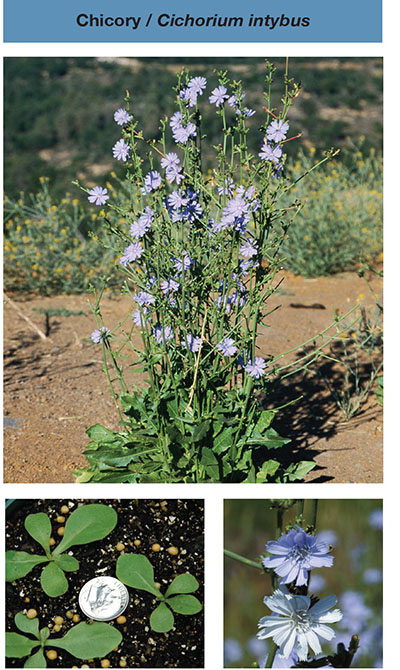
(Photos: top and bottom right by Joseph M. DiTomaso, University of California–Davis; bottom left by Bruce Ackley, The Ohio State University, all via Bugwood.org.)
Class B
Chicory / Cichorium intybus
Biennial or perennial that infests disturbed areas, such as roadsides, railroads, and waste grounds. Chicory plants resemble dandelion plants when in the rosette stage.
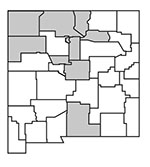
Also Known As: Blue daisy, blue sailors, blueweed, bunk, coffeeweed, succor
Stems/Leaves: Foliage is glabrous to short-bristly-hairy; stems (3 ft tall) herbaceous, branching, erect, with a milky sap; leaves (3–10 in. long) toothed to deeply lobed along the margins; upper stem leaves few, smaller in size, sessile, with margins entire or lobed, clasping the stem.
Flowers: Dandelion-like flowers (1–2 in. diameter) are mostly blue but occasionally white or purple; petals are squared and toothed at the tip.
Roots: Taproot sometimes weakly woody with a milky sap.
Reproduction: Seed; seeds are dispersed mainly by human activities, and therefore effective management can prevent their spread.
Management Do’s and Don’ts
• Cultivation is effective.
• No known biological controls exist.
• Mowing is NOT effective.
• Herbicides are effective.
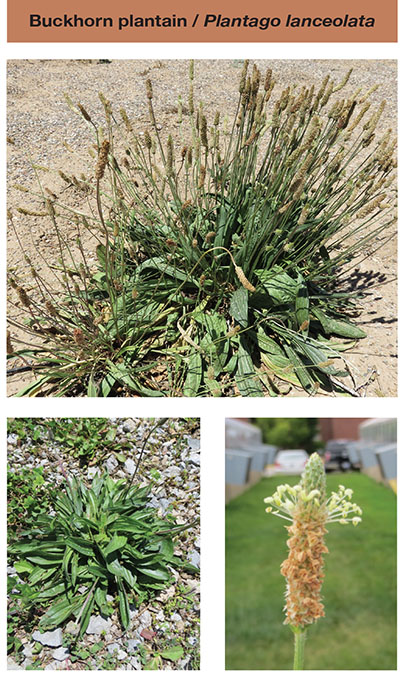
(Photos by Leslie Beck, NMSU.)
Troublesome Weed
Buckhorn plantain / Plantago lanceolata
Perennial herbaceous plant that is commonly found in moist soils and disturbed sites, such as roadsides, ditch banks, rangelands, pastures, and agricultural fields.
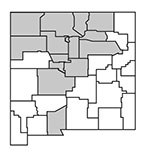
Also Known As: English plantain, narrowleaf plantain, ribgrass
Stems/Leaves: Acaulescent perennial with spirally arranged rosette; leaves are arranged on very short petioles; blades are lanceolate (up to 24 in. long), thick and leathery, long and attenuate at the base, sparsely pubescent to smooth, with five very deep and distinctive veins.
Flowers: Inflorescences are perched atop long peduncles (up to 35 in. tall) with flowers in leafless spikes that look like dense cone- or egg-like clusters with distinctly triangular bracts.
Roots: Taproot with numerous fibrous lateral roots.
Reproduction: Seed; successful management prevents seed production/spread.
Management Do’s and Don’ts
• Deep cultivation may help with control but may not be practical.
• Mowing before seed formation can help prevent spread but will not control the plant.
• Herbicides are effective.
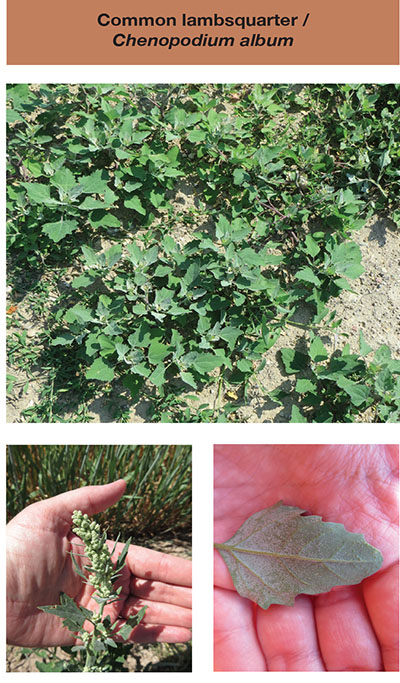
(Photos by Leslie Beck, NMSU.)
Troublesome Weed
Common lambsquarter / Chenopodium album
Annual herbaceous plant that is found in disturbed areas, cultivated fields, roadsides, rangelands, pastures, and landscapes.
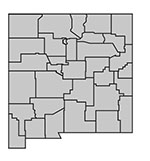
Also Known As: Goosefoot
Stems/Leaves: Stems erect (20 in. tall) to sprawling; plants grayish in color with distinctive purple stripes along the length of the stems; leaves are alternate with blades that are deltoid or oval in shape, margins can be entire to wavy or irregularly toothed; herbage can be sparsely to densely farinose (the hairs appear blister-like, becoming mealy), which aides in the grayish green color.
Flowers: Inconspicuous, green, and clustered; clusters are arranged in terminal and lateral spikes, and look similar to those of cauliflower.
Roots: Taproot
Reproduction: Seed; successful management prevents seed production/spread.
Management Do’s and Don’ts
• Physical removal or damage prior to seed production can help prevent spread and deplete the seedbank.
• Shallow tillage and cultivation can help with control prior to seed production.
• Herbicides are effective.
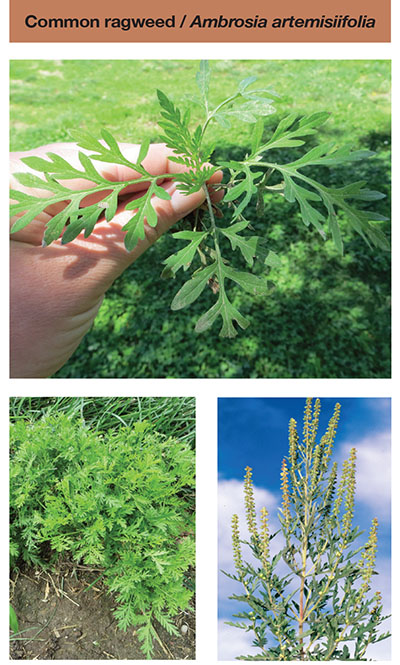
(Photos: top and bottom left by Leslie Beck, NMSU; bottom right by Steve Dewey, Utah State University, Bugwood.org.)
Troublesome Weed
Common ragweed / Ambrosia artemisiifolia
Annual herbaceous plant that is found in disturbed areas, cultivated fields, roadsides, rangelands, pastures, and landscapes. Pollen is a common contributor to seasonal allergies in people.
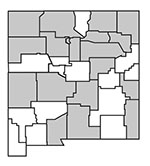
Also Known As: Annual ragweed
Stems/Leaves: Stems erect and mostly branching; entire plant is variously pubescent; leaves are opposite toward the base of the plant and alternating at the top; middle and lower leaves are distinctly larger than those at the top of the plant; blades are once or twice pinnatifid, strigillose, and gland dotted.
Flowers: Pistillate and staminate flowers in separate heads, although all are discoid in shape; staminate heads are nodding in terminal racemes.
Roots: Taproot
Reproduction: Seed; successful management prevents seed production/spread.
Management Do’s and Don’ts
• Physical removal or damage prior to seed production can help prevent spread and deplete the seedbank.
• Shallow tillage and cultivation can help with control prior to seed production.
• Herbicides are effective.
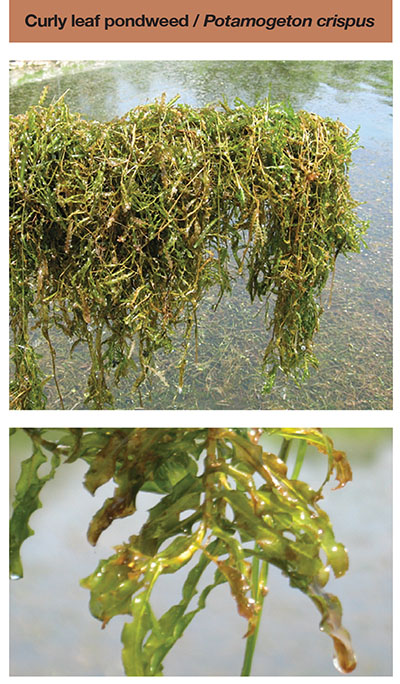
(Photos by Chris Evans, University of Illinois, Bugwood.org.)
Class C
Curly leaf pondweed / Potamogeton crispus
Aquatic perennial that infests riparian areas, such as lakes, ponds, rivers, streams, and irrigation ditches; usually found in still or slow-moving water, but occasionally in fast-moving streams or rivers.
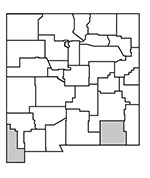
Also Known As: Curly pondweed
Stems/Leaves: Stems (up to 10–40 in. long) flattened and sparingly branched with a jointed appearance; leaves are submersed, sessile, and more or less arranged spirally along the stems; blades can be translucent and linear with a rounded base and a rounded to nearly pointed tip.
Flowers: Inflorescence is a small, dense, cylindrical spike of flowers that is upright and often emergent from the water; flowers are greenish and tiny with four tepals and four stamens, with two-chambered anthers and four edge-to-edge sepal-like outgrowths.
Roots: Numerous creeping, branched rhizomes that form large, thick surface or subsurface mats.
Reproduction: Vegetative reproduction from rhizomes, stem fragments, or buds on leaf axils, and seed production.
Management Do’s and Don’ts
• Repeated mechanical removal is effective at controlling density, but stem fragments may escape and form new infestations.
• Removing stem fragments and plant parts from boats, lines, and fishing gear can help prevent spread of infestations.
• Herbicides are effective.
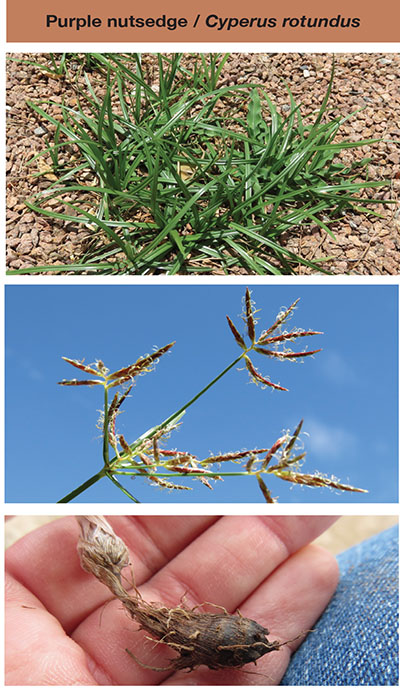
(Photos by Leslie Beck, NMSU.)
Troublesome Weed
Purple nutsedge / Cyperus rotundus
Perennial graminoid that is generally found in disturbed sites, often in very moist or poorly drained soils.

Also Known As: Purple flat sedge, nutgrass, cocograss, kili’o’opu
Stems/Leaves: Stems are three-sided (triangular) in cross-section, smooth, and hardened basally; leaves are distinctly v-shaped with deep, rough margins on the upper half with a very thick and shiny epicuticular wax coating.
Flowers: Inflorescence is a subtending bract that is v-shaped; flowers are distinctly purple to reddish in color and appear similar to long cones that are dispersed along multiple spikes.
Roots: Fibrous root system with multiple tubers connected through multiple rhizomes.
Reproduction: Spread vegetatively through tubers and rhizomes; can produce some seed.
Management Do’s and Don’ts
• Physical removal or damage is generally not effective due to extensive tuber and rhizome systems.
• Herbicides are effective.
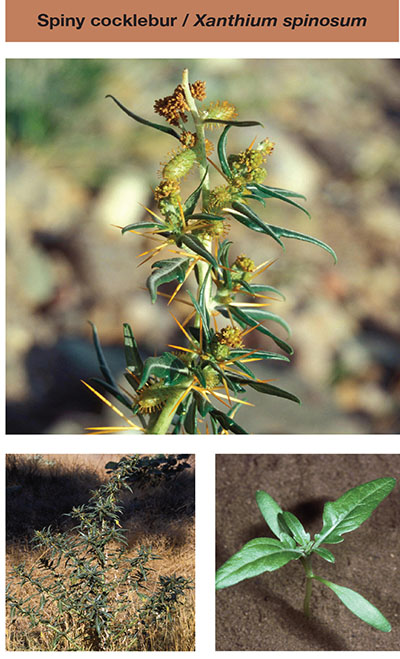
(Photos: top by John M. Randall, The Nature Conservancy; bottom left and right by Joseph M. DiTomaso, University of California–Davis, all via Bugwood.org.)
Class B
Spiny cocklebur / Xanthium spinosum
Annual plant that infests disturbed areas, such as roadsides, ditches, fields, pastures, orchards, riparian areas, and waste areas.
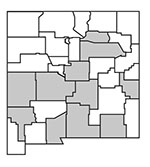
Also Known As: Bathurst burr, clotweed, dagger cocklebur, Spanish thistle, spiny clotbur
Stems/Leaves: Stems (up to 3 ft tall) tough, branched, with three-branched, yellowish spines (0.5–1 in. long) on the leaf axils; leaves lanceolate, underside densely covered with white wooly hairs; leaf margins entire to toothed lobed (1–4 in. long) and with one main vein from the base.
Flowers: Male and female flowers develop in separate heads on the leaf axils of the same plant; male flower heads are small, green, and develop in clusters; female flower heads develop on the leaf axils below the male flower heads singly or in small clusters; spiny female flower heads consist of two flowers that lack corollas and become hardened prickly burs that enclose two seeds at maturity.
Roots: Taproot, often branched.
Reproduction: Seed; successful management prevents seed production/spread.
Management Do’s and Don’ts
• Manual removal is effective, especially before burs develop.
• DO NOT cut and leave the plants with immature burs on the site because they can still develop viable seed.
• Some herbicides are effective.
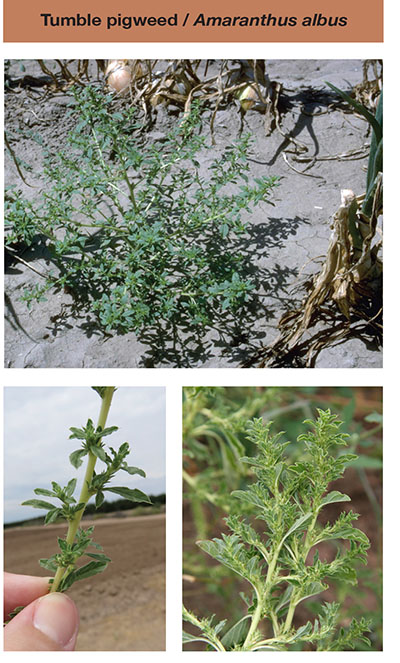
(Photos: top by Howard F. Schwartz, Colorado State University, Bugwood.org; bottom right by Robert Vidéki, Doronicum Kft., Bugwood.org; bottom left by Leslie Beck, NMSU.)
Troublesome Weed
Tumble pigweed / Amaranthus albus
Annual herbaceous plant that is found in disturbed areas, cultivated fields, roadsides, rangelands, pastures, and landscapes. Commonly an agricultural weed.

Also Known As: None
Stems/Leaves: Stems usually erect (up to 40 in. tall), rarely prostrate, and much-branched, giving the plant a very “bushy” appearance; leaves are alternate with a petiole half as long as the blade, but may be longer in young proximal leaves; leaf blades are obovate to narrowly spatulate with a tapering base; leaf margins are generally entire but may be slightly undulate with whitish or yellowish short spines.
Flowers: Inflorescences are axillary glomerules with male and female flowers intermixed; flowers are green, whitish-green, or yellowish in color.
Roots: Taproot
Reproduction: Seed; successful management prevents seed production/spread.
Management Do’s and Don’ts
• Physical removal or damage prior to seed production can help prevent spread and deplete the seedbank.
• Shallow tillage and cultivation can help with control prior to seed production.
• Herbicides are effective.
References
AquaPlant. 2006. Giant salvinia – management options. College Station: Texas Cooperative Extension, Department of Wildlife and Fisheries Sciences, Texas AandM University.
Bonneau, A. 2000. Gutierrezia sarothrae (Pursh) Britt. and Rusby. Saskatoon, Saskatchewan, Canada: University of Saskatchewan.
Brand, M. 2001. University of Connecticut plant database. Storrs: University of Connecticut.
Cranston, R., D. Ralph, and B. Wikeem. 2002. Field guide to noxious and other selected weeds of British Columbia. British Columbia, Canada: Ministry of Agriculture and Lands.
DiTomaso, J.M., and E.A. Healy. 2003. Aquatic and riparian weeds of the west. Oakland: University of California Agriculture and Natural Resources Communication Services.
DiTomaso, J.M., and E.A. Healy. 2007. Weeds of California and other western states. Oakland: University of California Agriculture and Natural Resources Communication Services.
Gerlach, J.D., and J.M. DiTomaso. 2006. Centaurea melitensis. California Invasive Plant Council.
Hartman, R.L. 2010. Drymaria. eFloras.org.
Hurteau, M.D. 2002. Broom snakeweed Gutierrezia sarothrae (Pursh) Britt. and Rusby. In PLANTS Database, USDA, NRCS. Baton Rouge, LA: National Plant Data Center.
Illinois Wildflowers. 2020. Whorled milkweed: Asclepias verticillata.
Mohlenbrock, R.H. (Ed.). 2007. The illustrated flora of Illinois. pp. 203–205. Carbondale: Southern Illinois University Press.
Moore, L.M., and K. Davis. 2002. Siberian elm Ulmus pumila. In PLANTS Database, USDA, NRCS. Baton Rouge, LA: National Plant Data Center.
Pell, S.K., and B. Angell. 2016. A botanist’s vocabulary. Portland, OR: Timber Press, Inc.
Scher, J.L., and D.S. Walters. 2010. Federal noxious weed disseminules of the U.S., Drymaria arenarioides Humb. and Bonpl. ex Schultes. California Department of Food and Agriculture, and Center for Plant Health Science and Technology, USDA, APHIS, PPQ.
SEINet Data Portal. 2020. http://swbiodiversity.org/seinet/
The Ohio State University. 2020. Ohio perennial and biennial weed guide: Bouncingbet (Saponaria officinalis).
United States Congress. 1974. Federal Noxious Weed Act. 2801–2814.
United States Department of Agriculture. 2020. Field guide for managing buffelgrass in the Southwest.
Washington State Noxious Weed Board. 2005. Information about meadow knapweed – Centaurea jacea × nigra.
Washington State Noxious Weed Board. 2020. Myrtle spurge – Euphorbia myrsinites.
Whitson, T.D. (Ed.). 2004. Weeds of the west. Laramie: University of Wyoming.
Wieseler, S. 2005. Siberian elm (Ulmus pumila). Plant Conservation Alliance.
Zouhar, K. 2005. Elaeagnus angustifolia. Fire Effects Information System. U.S. Department of Agriculture, Forest Service, Rocky Mountain Research Station, Fire Sciences Laboratory.
Glossary
acaulescent – having no stem or appearing to have none
achene – a small, dry, one-seeded fruit that does not open to release the seed
alternate – leaves that grow singly along the stem and are not opposite
annual – a plant that completes its life cycle in a single year and reproduces by seed only
attenuate – gradually growing to a point
auricle – a small ear-like structure at the base of a leaf or petal
axil – the point at which a leaf joins the stem
basal – referring to the base of the plant
biennial – a plant that completes its life cycle over two years
bract – a leaf- or scale-like structure, usually small, found on or just below a flower or flower head
calyx – collective term for flower sepals
cauline – emerging from or pertaining to the stem, applied most often to leaves
cespitose – growing in dense clusters
ciliate – with a fringe of hairs extending from the margin
corolla – a whorl of sepals or petals, usually found on the outer edge of the flower
creeping – a root or root system that grows horizontally either above or below the soil surface
crenate – having a scalloped margin
cyme – unbranched or branched inflorescence with the axis terminating in the oldest flower that is basally or centrally located; younger flowers branch on one or more sides
decumbent – lying or growing flat along the ground with the ends turning upward
deltoid – equilateral triangle-shaped
dentate – having teeth pointing outward, perpendicular to the margin
emersed – growing above the water surface
entire – leaf margins that are smooth and do not have teeth or lobes
epicuticular wax – a coating of wax covering the outer surface of the plant cuticle
floret – a small or reduced flower, especially one of the grasses or sunflowers
forb – broadleaf herbaceous, non-tree-like plant, often applied to non-grass-like herbaceous plants that are grazed by animals
glabrous – without hairs
glomerules – dense clusters
graminoid – an herbaceous plant with a grass-like morphology (e.g., elongated culms [hollow stems] with long, blade-like leaves)
herbaceous – a plant with the characteristics of an herb (i.e., leafy and green) and that is not woody
hirsute – having stiff, rough hairs
inflorescence – a group or cluster of flowers on a stem
keeled – a leaf with a raised or projected midvein that resembles the keel of a boat
lanceolate – shaped like a lance, much longer than wide, broad at the base and tapered toward the end
ligule – a thin membrane located at the junction of the leaf base and the leaf sheath or stem
linear – a very narrow leaf, much longer than wide, with parallel edges
lobed – a leaf edge that has lobes, usually rounded, the edges of which cut deeply to the midvein
margin – the edge of a leaf
midvein – the middle and often most prominent vein on a leaf
monoecious – plants with separate male and female flowers on the same plant
noxious – any foreign plant (not native to the U.S.) that has the potential to be harmful to crops, livestock, other useful plants and animals, agricultural interests, or public health
oblanceolate – lance-shaped with the widest point toward the top
oblong – a leaf that is two to four times longer than it is wide, with edges that are parallel or nearly parallel
obtuse – rounded apex or base with curved sides forming a >90° angle
opposite – leaves that grow in pairs along a common axis and are directly across from one another
panicle – a compound inflorescence in which the branches are racemes, with younger flowers growing at the top
papilla (plural papillae) – short, rounded, nipple-like protuberance
pedicel – the stalk of an individual flower within an inflorescence
peduncle – the stalk of a solitary flower or an entire inflorescence
perennial – a plant that completes its life cycle in more than two years
perianth – the outer part of a flower, consisting of the calyx (sepals) and corolla (petals)
petaloid – petal-like; may apply to any floral whorl
petiolate – having a petiole
petiole – leaf stalk that connects the leaf blade to the stem
pinnate – a compound leaf with leaflets that grow oppositely on two sides of a common, elongated axis
pinnatifid – pinnately cleft or lobed half the distance or more to the midrib, but not reaching the midrib
pistillate – having female reproductive structures (pistils) and lacking male structures (stamens)
raceme – an inflorescence with flowers growing singly along an elongated, unbranched axis or stem
rachis – the central axis of a branched or dissected organ, such as a pinnate leaf or an inflorescence
retroflex – turned backward
rhizome – an elongated stem that grows partially or completely below the soil surface
scabrous – rough to the touch, like sandpaper
sepal – leaf- or petal-like appendages that are the outermost part of a flower, usually found just below the petals
serrate – a leaf edge with numerous small teeth that resemble the teeth on a saw and point toward the leaf tip
sessile – lacking a stalk; e.g., a leaf without a petiole
sheath – the lower, tubular portion of a leaf that normally surrounds the stem
simple – 1) an undissected leaf; 2) an unbranched inflorescence
spreading – growing along the ground
staminate – having male reproductive structures (stamens) and lacking female structures (pistils)
stipule – a small leaf-like structure found at the base of a leaf or leaf stalk, usually found in pairs
stolon – horizontal, aboveground, creeping stem with roots and shoots forming at nodes and the tip
strigillose – set with stiff, slender bristles
submersed – growing below the water surface
subtend – occurring under another structure or organ
taproot – the main root of a plant that grows vertically into the soil
tepal – individual component of a perianth when the sepals and petals are petaloid
toothed – a leaf edge that has teeth-like projections
umbel – inflorescence with flowers or branches borne from a common point, presenting flowers on a rounded or flat plane at the top; may be simple (unbranched) or compound (branched)
vernation – arrangement of leaves in the bud
wavy – a leaf edge with curls, wrinkles, or waves, but NOT teeth, lobes, etc.
whorled – three or more leaves that are arranged in a circle around a stem or common axil
For Further Reading
Guide A-616: Herbicide Resistance: Development and Management
https://pubs.nmsu.edu/_a/A616/
CR-597: Chemical Weed and Brush Control for New Mexico Rangelands
https://pubs.nmsu.edu/_circulars/CR597/
CR-678: Poisonous Plants of New Mexico Rangelands
https://pubs.nmsu.edu/_circulars/CR678/

Leslie Beck is the Extension Weed Specialist at New Mexico State University. Her research program focuses on integrated weed management systems in landscape, horticultural, and agronomic crops. Her Extension work provides the citizens of New Mexico with accurate, applicable, and effective weed identification and management strategies in multiple cropping systems.
To find more resources for your business, home, or family, visit the College of Agricultural, Consumer and Environmental Sciences on the World Wide Web at pubs.nmsu.edu.
Contents of publications may be freely reproduced, with an appropriate citation, for educational purposes. All other rights reserved. For permission to use publications for other purposes, contact pubs@nmsu.edu or the authors listed on the publication.
New Mexico State University is an equal opportunity/affirmative action employer and educator. NMSU and the U.S. Department of Agriculture cooperating.
May 2021, Las Cruces, NM


